Prediction of Deflection of Reinforced Concrete Beams Strengthened with Fiber Reinforced Polymer
Abstract
:1. Introduction
2. Analyzed Beams
3. Calculation of Deflection
4. Results
5. Conclusions
Author Contributions
Funding
Acknowledgments
Conflicts of Interest
Notation
| A, B, C | the designation of the equation for the depth of the neutral axis; |
| Ac | the cross section of the compressed concrete layer; |
| Af | the cross-section area of carbon fiber; |
| Ared | the transformed cross section of the beam; |
| As1 and As2 | the cross-section area of the tensioned and compressed reinforcement; |
| Ecm | the modulus of elasticity of concrete; |
| Ef | the modulus of elasticity of carbon fiber; |
| Es1, Es2 | the modulus of elasticity of steel bars; |
| III, IIII | the effective moment of inertia at stages 2 and 3; |
| II.red, III.red, IIII.red | the moment of the inertia of the transformed cross-section at stages 1, 2, and 3; |
| MI and MI.S | the cracking moment of the unstrengthened beam and strengthened beam respectively; |
| MII.S | the bending moment of the strengthened beam when the yielding of reinforcement is reached; |
| MR, MII | the maximum carrying bending moment of the unstrengthened beam; |
| MR.S, MIII | the maximum carrying bending moment of the strengthened beam; |
| Sred | the static moment of the transformed cross-section; |
| a | distance from the support to loading; |
| b | the width of the beam; |
| d1 and d2 | distance from the beam edge to the center of the tensioned and compressed reinforcement; |
| fc | the compressive strength of concrete cylinders; |
| fct | the tensile strength of concrete; |
| h | the height of the beam; |
| k1 | the coefficient evaluating the shape of stress distribution; |
| l | the span length of the beam; |
| tf | the thickness of the carbon fiber layer; |
| xI, xII and xIII | the depth of the neutral axis at stages 1, 2 and 3; |
| yc.I, yc.II, yc.III, | the centre of the gravity of the beam cross-section at stages 1, 2 and 3; |
| αf, αs1, αs2 | relative coefficients; |
| γ1.c, γ1.t | relative coefficients evaluating a change in the depth of the neutral axis at stage 2; |
| γ2.c, γ2.t | relative coefficients evaluating a change in the depth of the neutral axis at stage 3; |
| εc | the strain of the compressed concrete; |
| εc1 | strain when the maximum strength of concrete material is reached; |
| εf | the strain of the carbon fiber layer; |
| εs | the strain of the tensioned reinforcement; |
| εs2 | the strain of the compressed reinforcement; |
| σc | stresses in the layer of the compressed concrete; |
| σf | stresses in the layer of carbon fiber; |
| σs | stresses in the tensioned reinforcement; |
| σs2 | stresses in the compressed reinforcement; |
| ωI, ωII | the deflection of the control beam up to the end of stages I and II. |
| ωI.S, ωII.S, ωIII.S | the deflection of the strengthened beam up to the end of stages I, II, and III. |
Appendix A
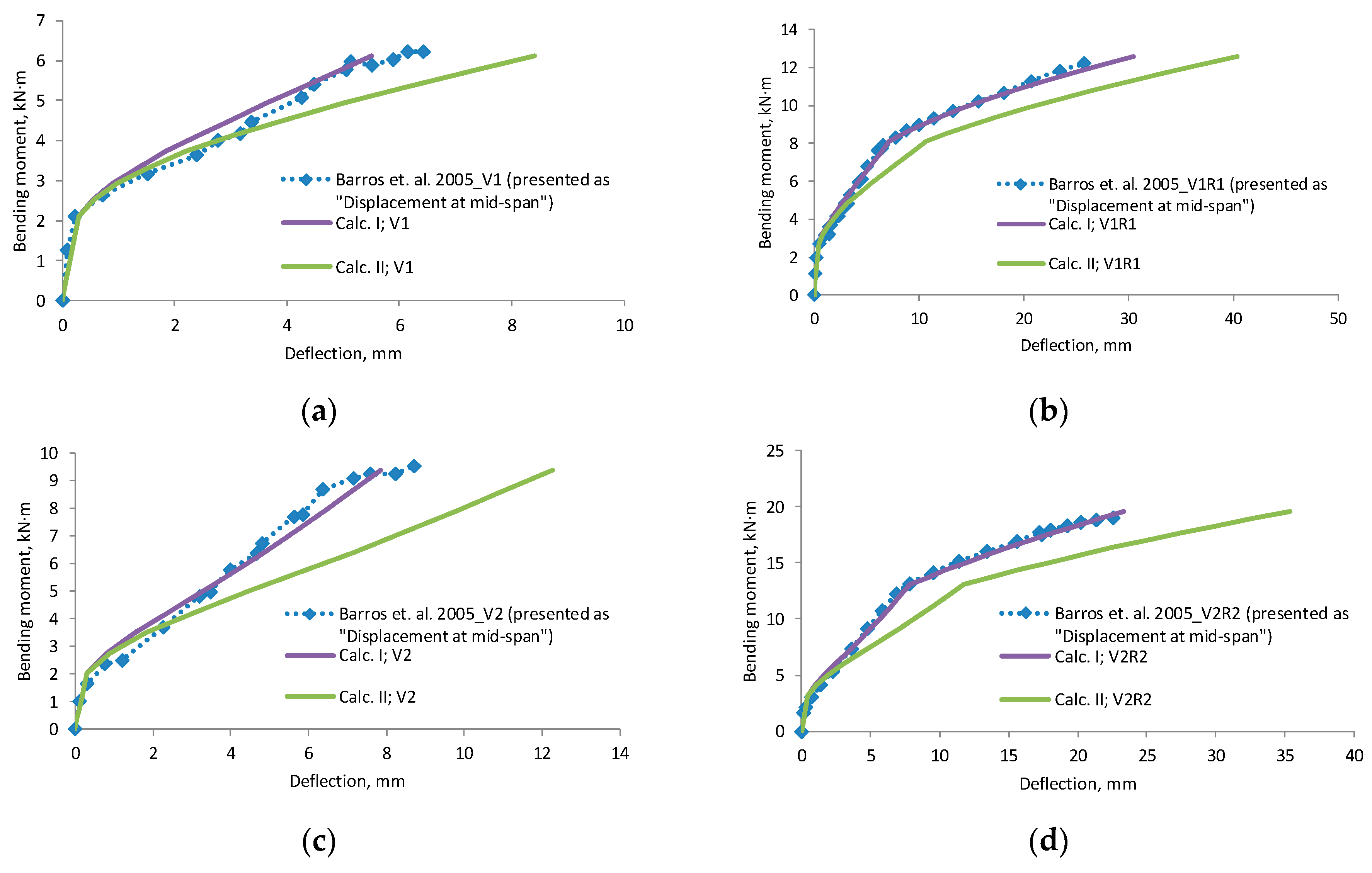
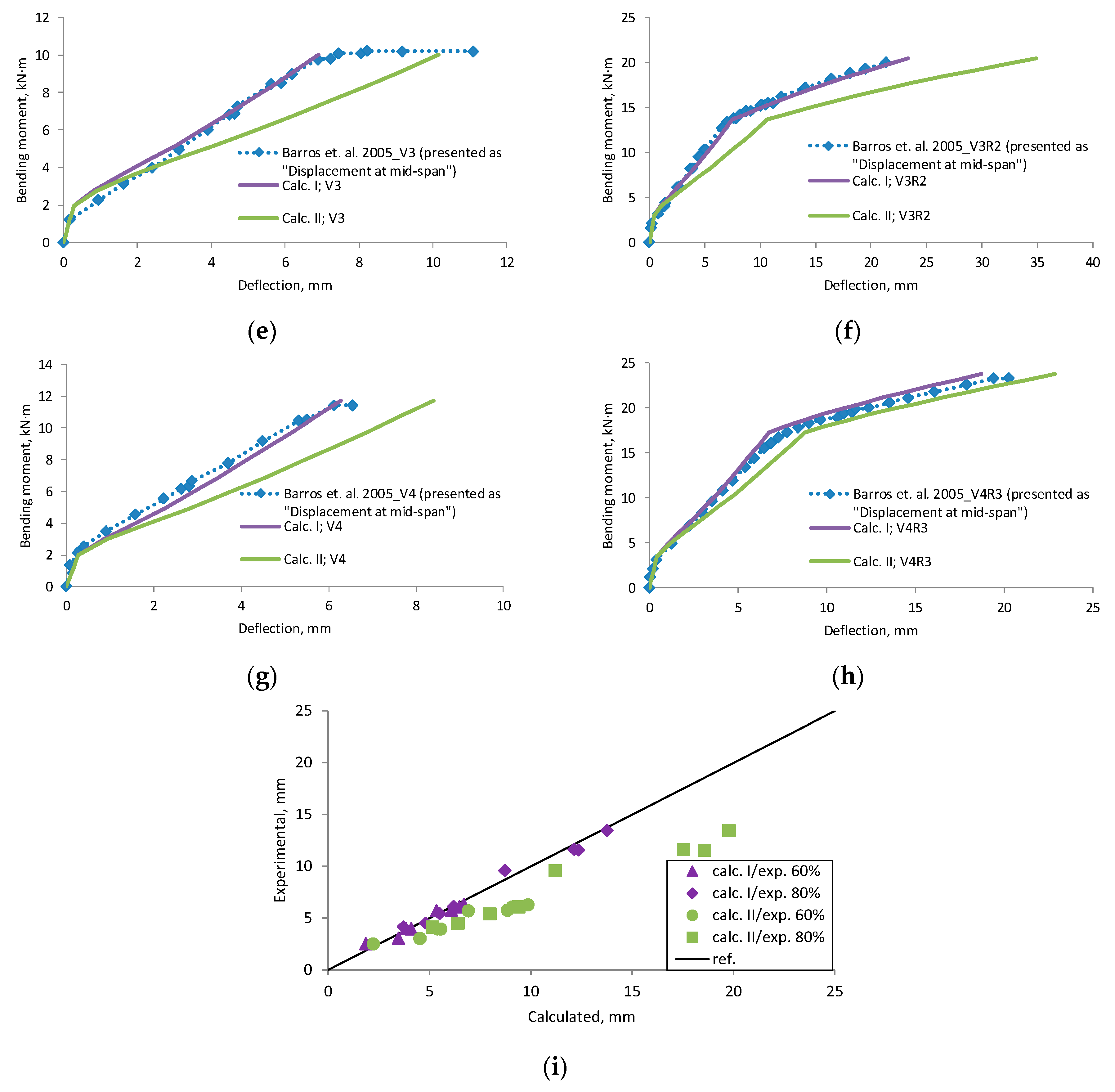

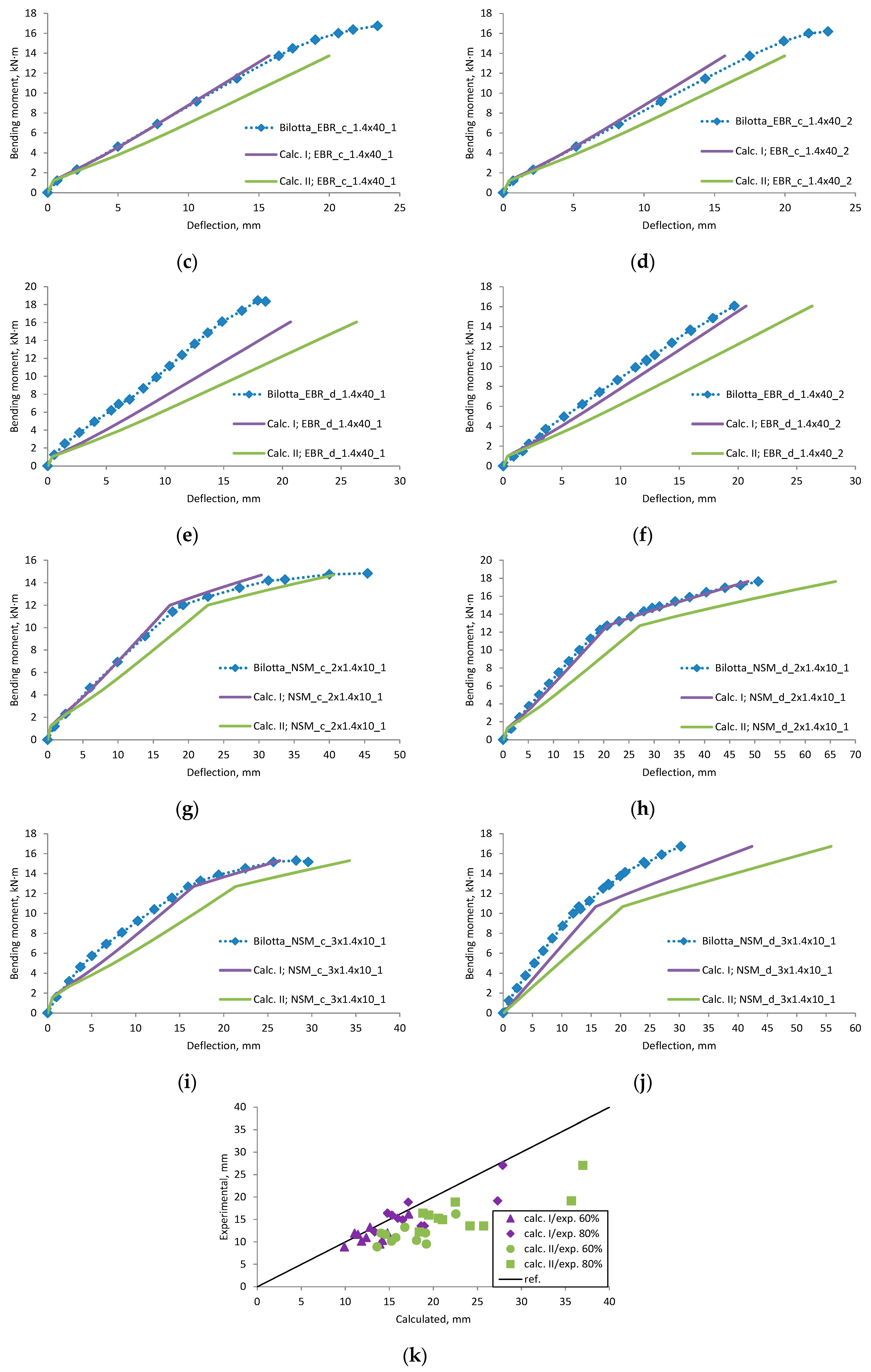
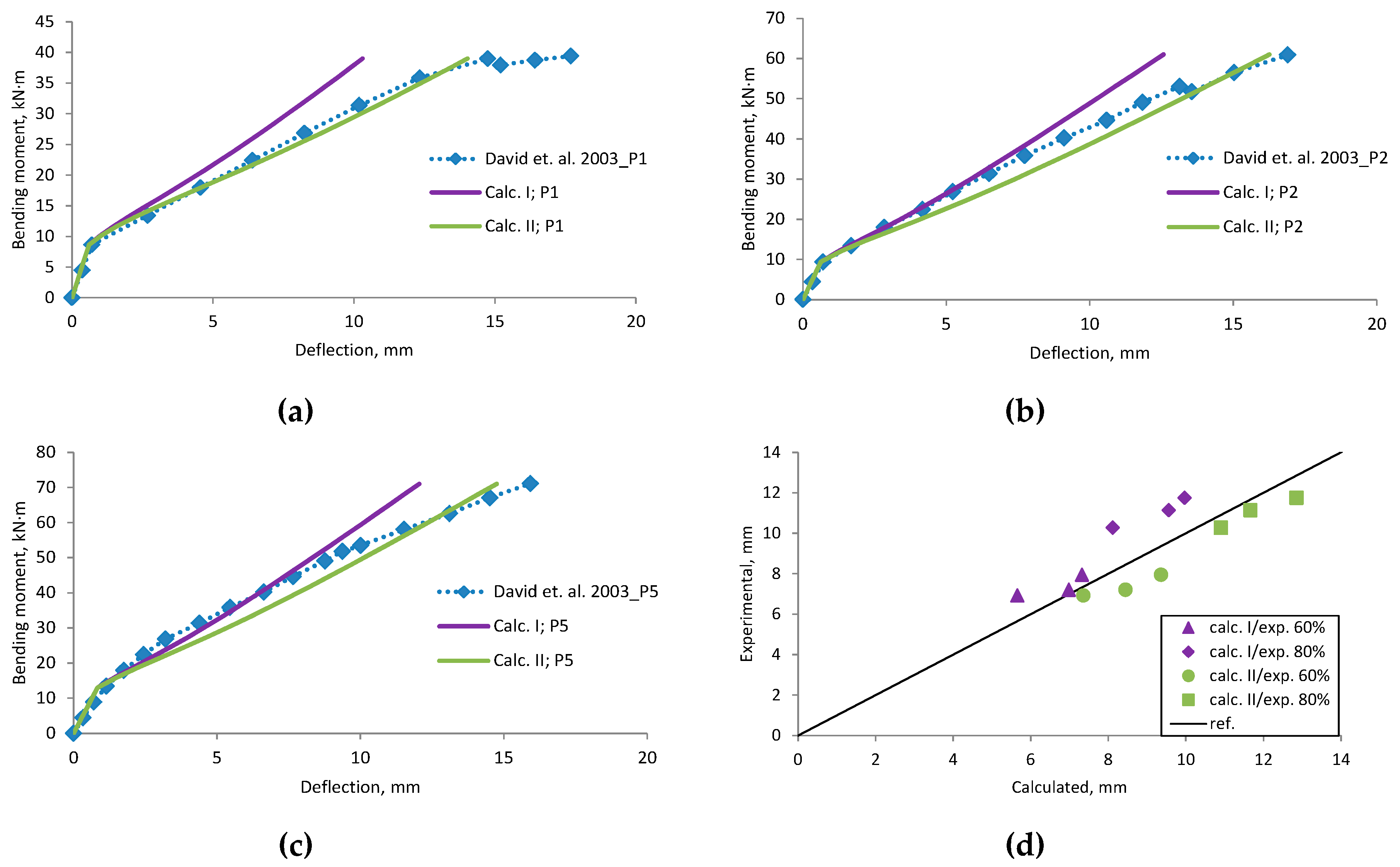
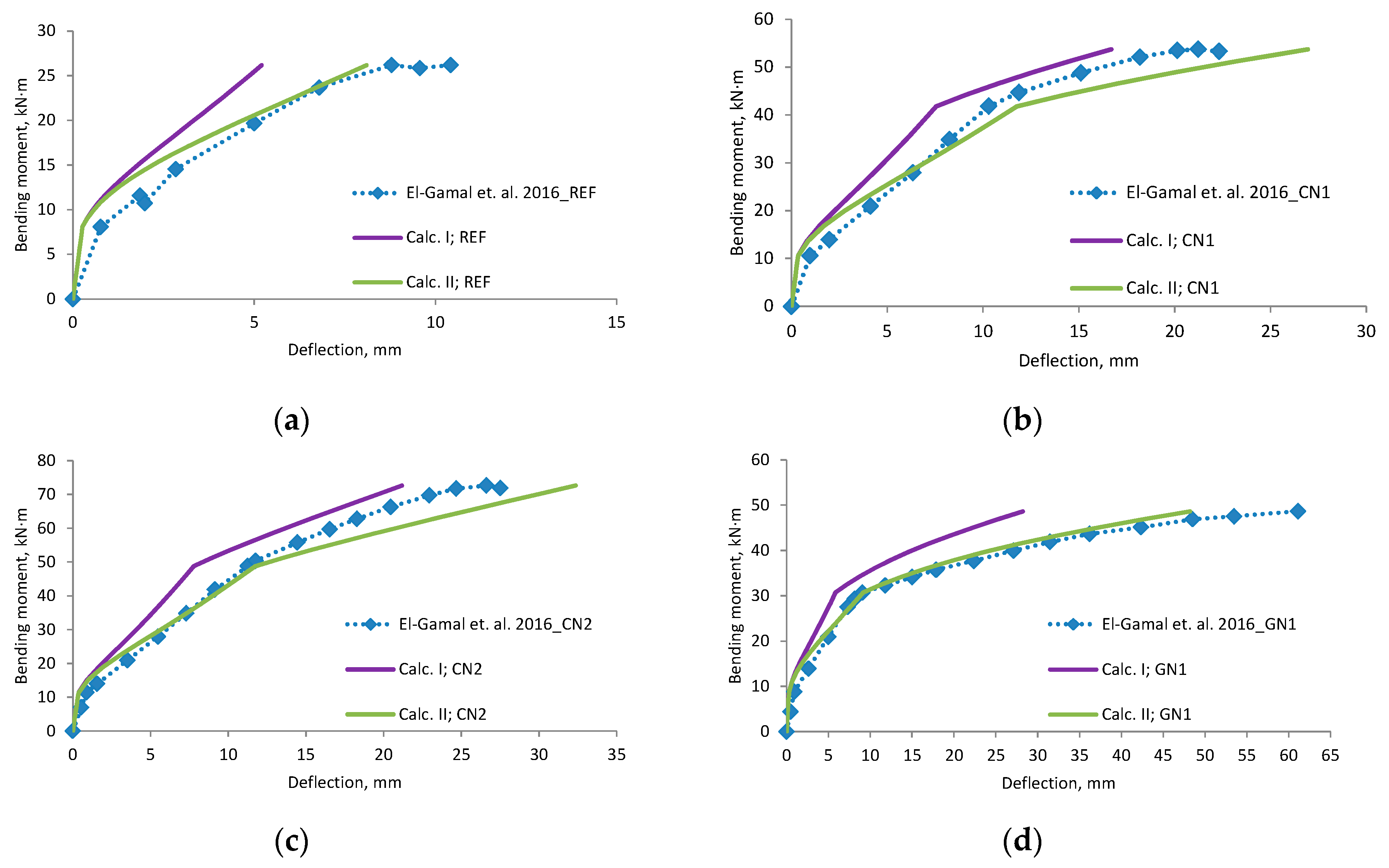

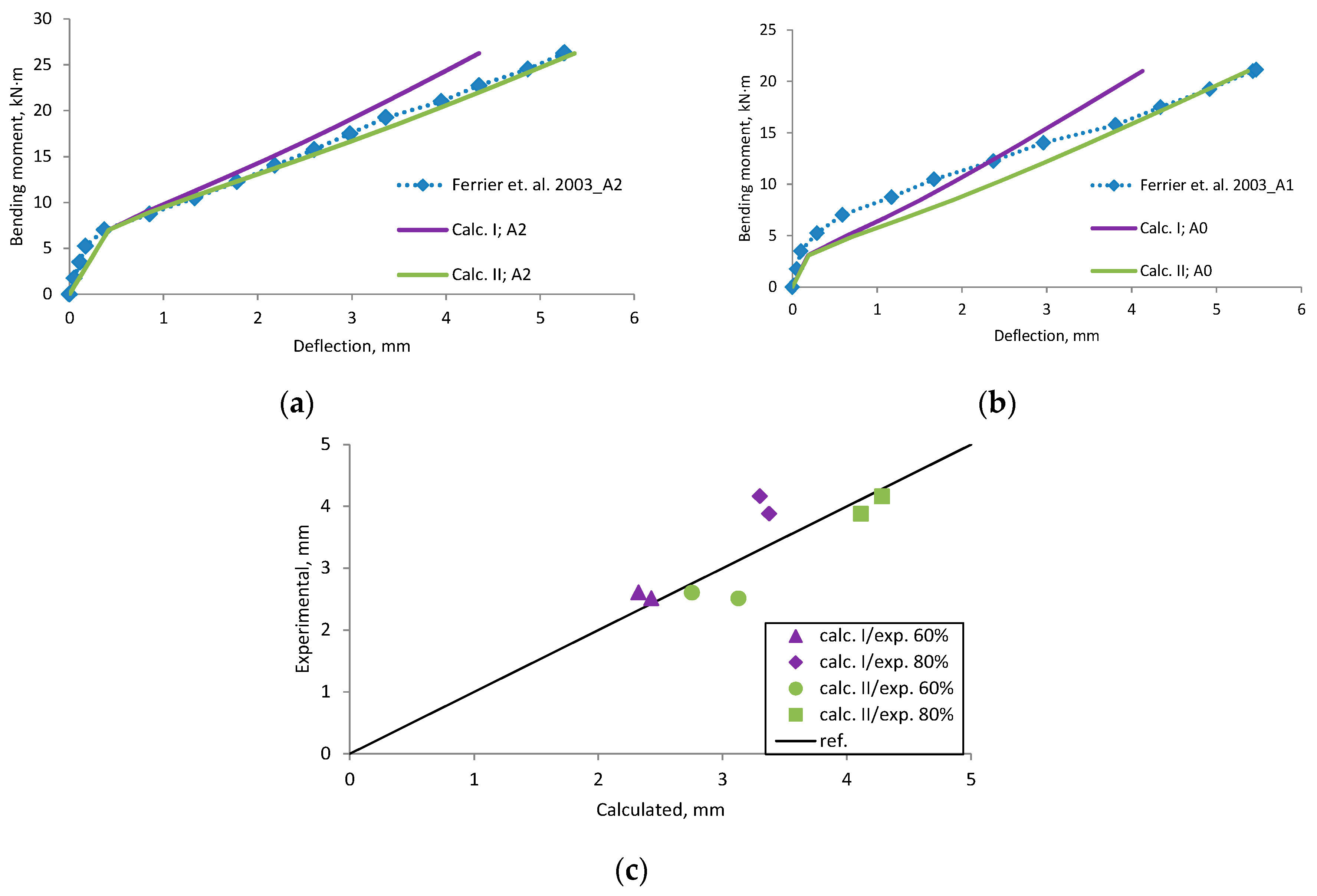
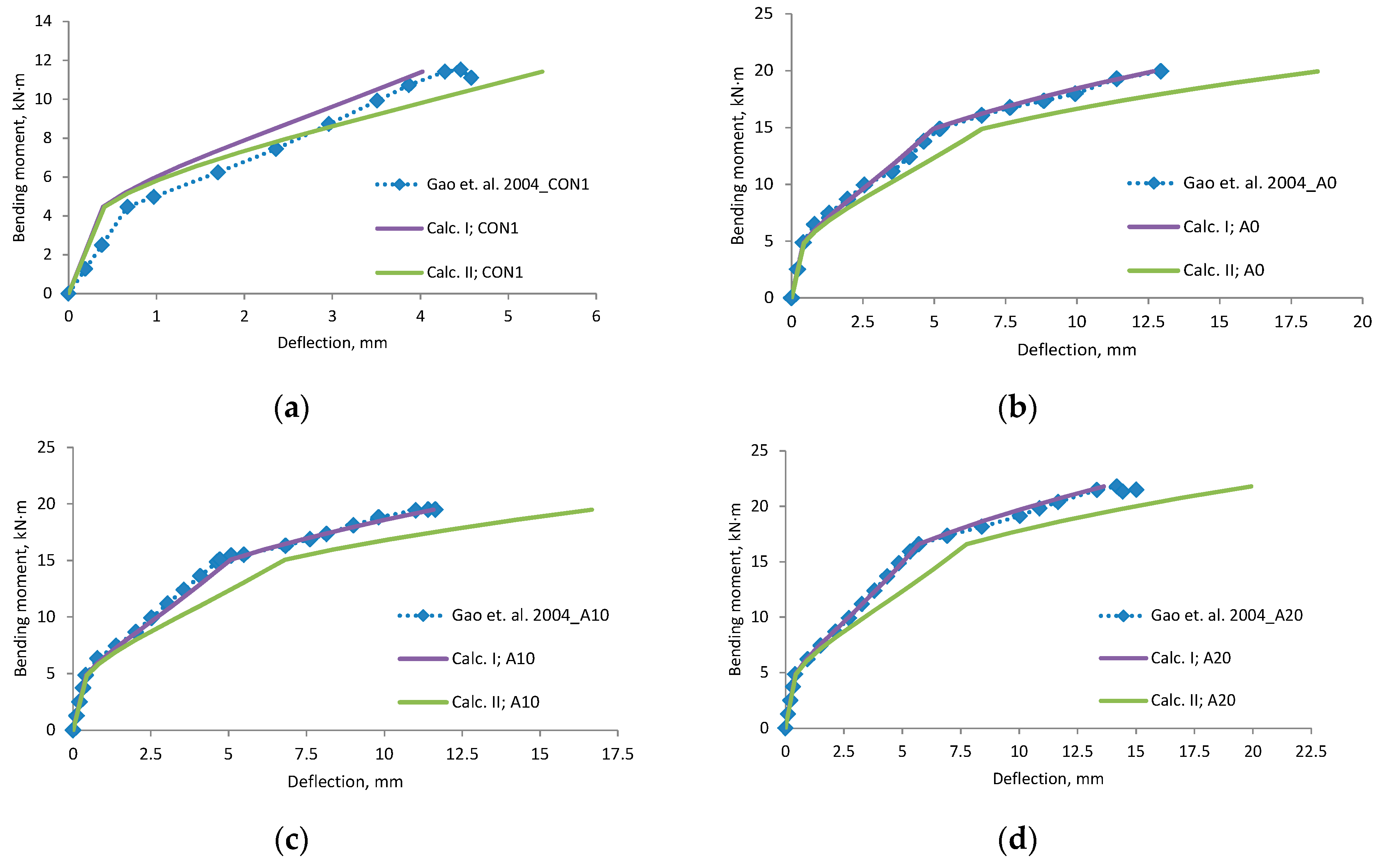
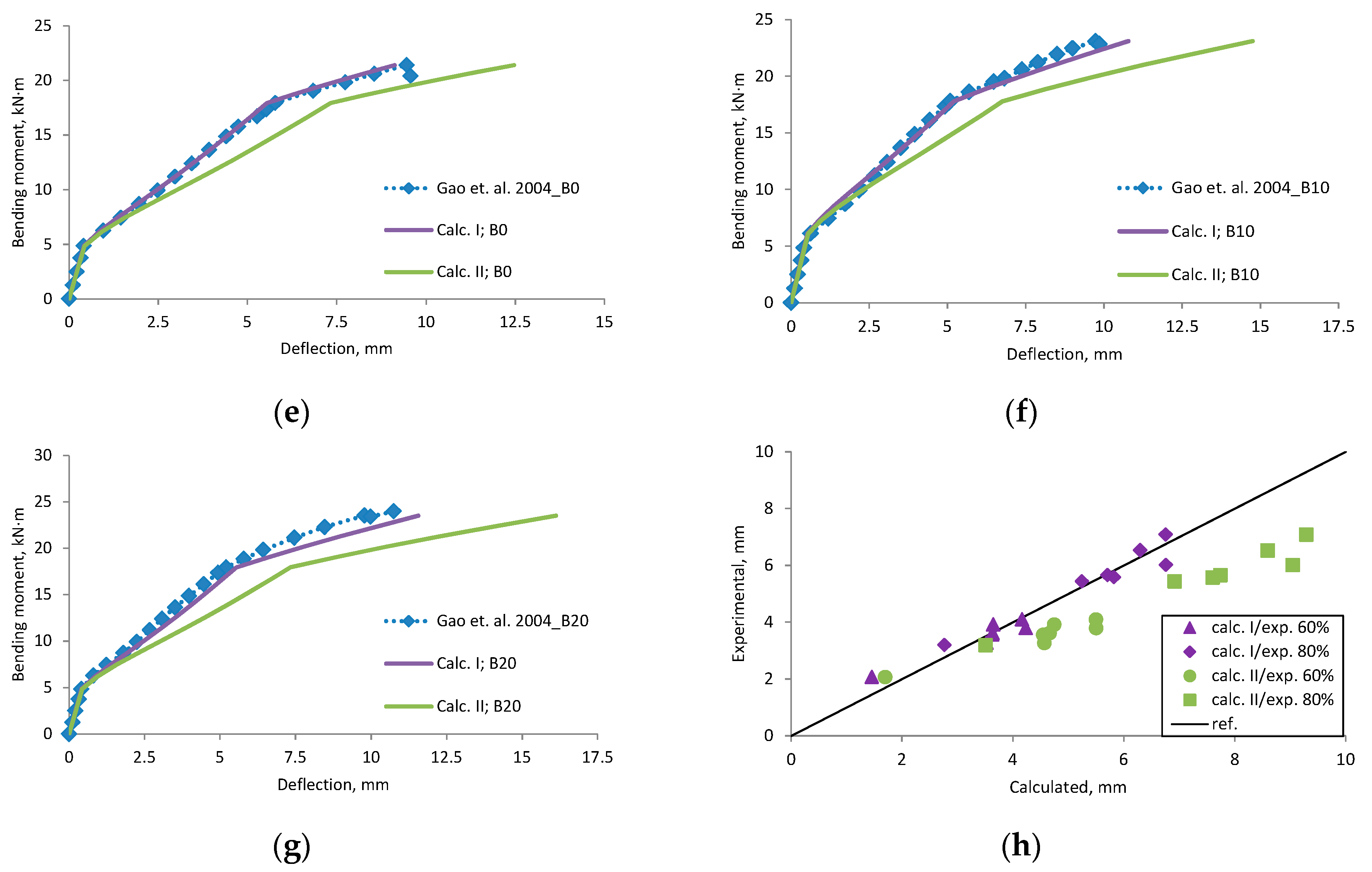
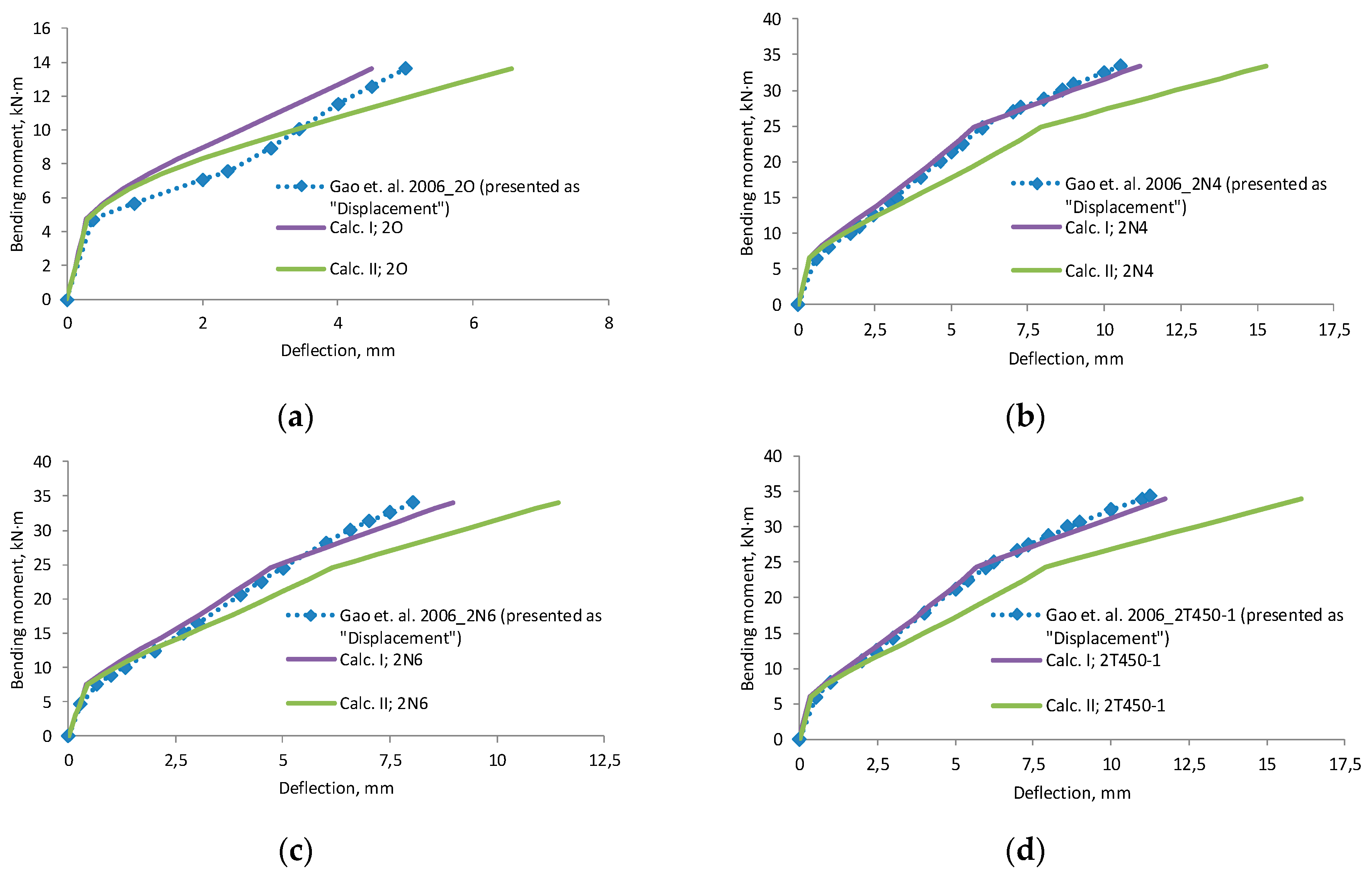


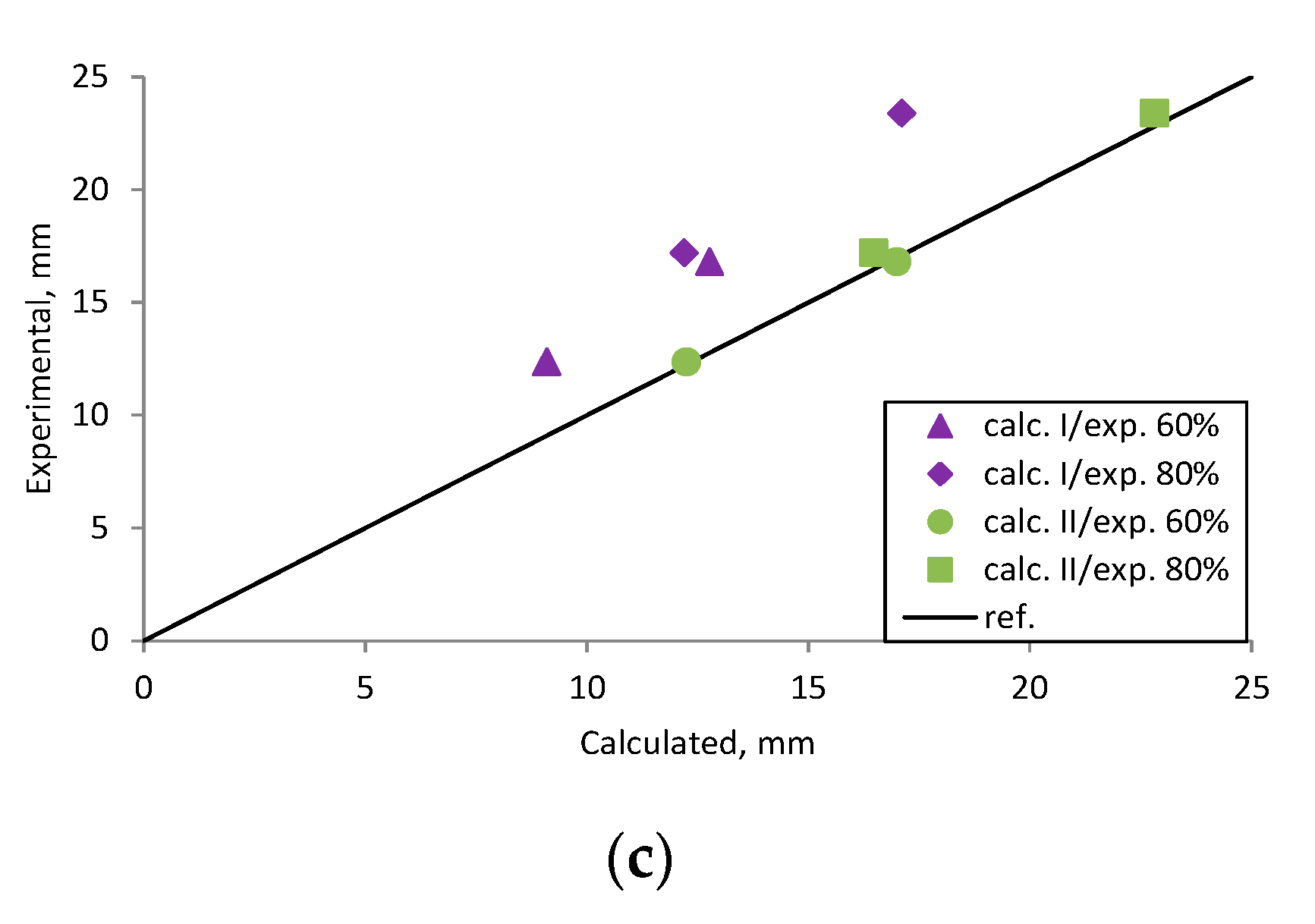
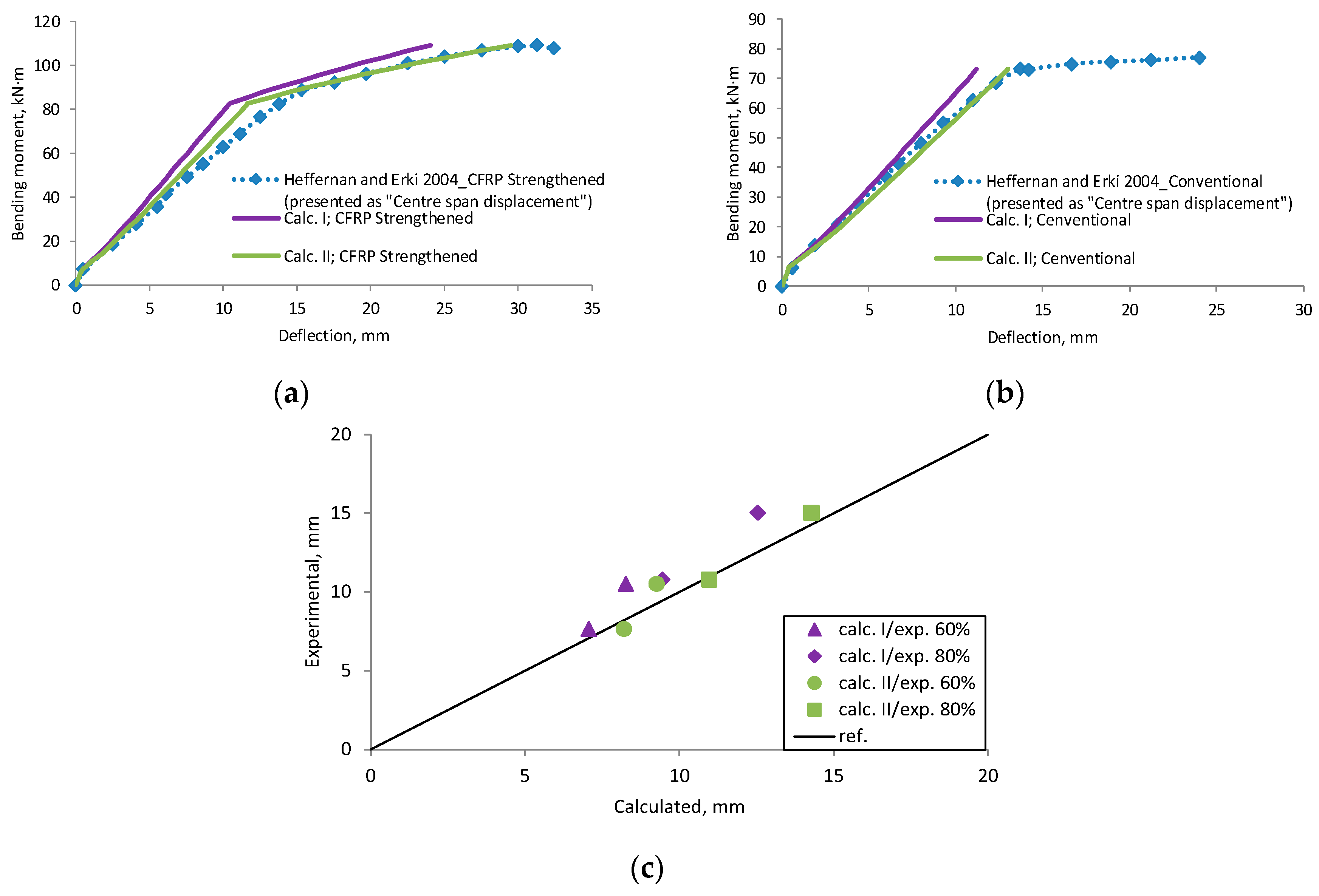

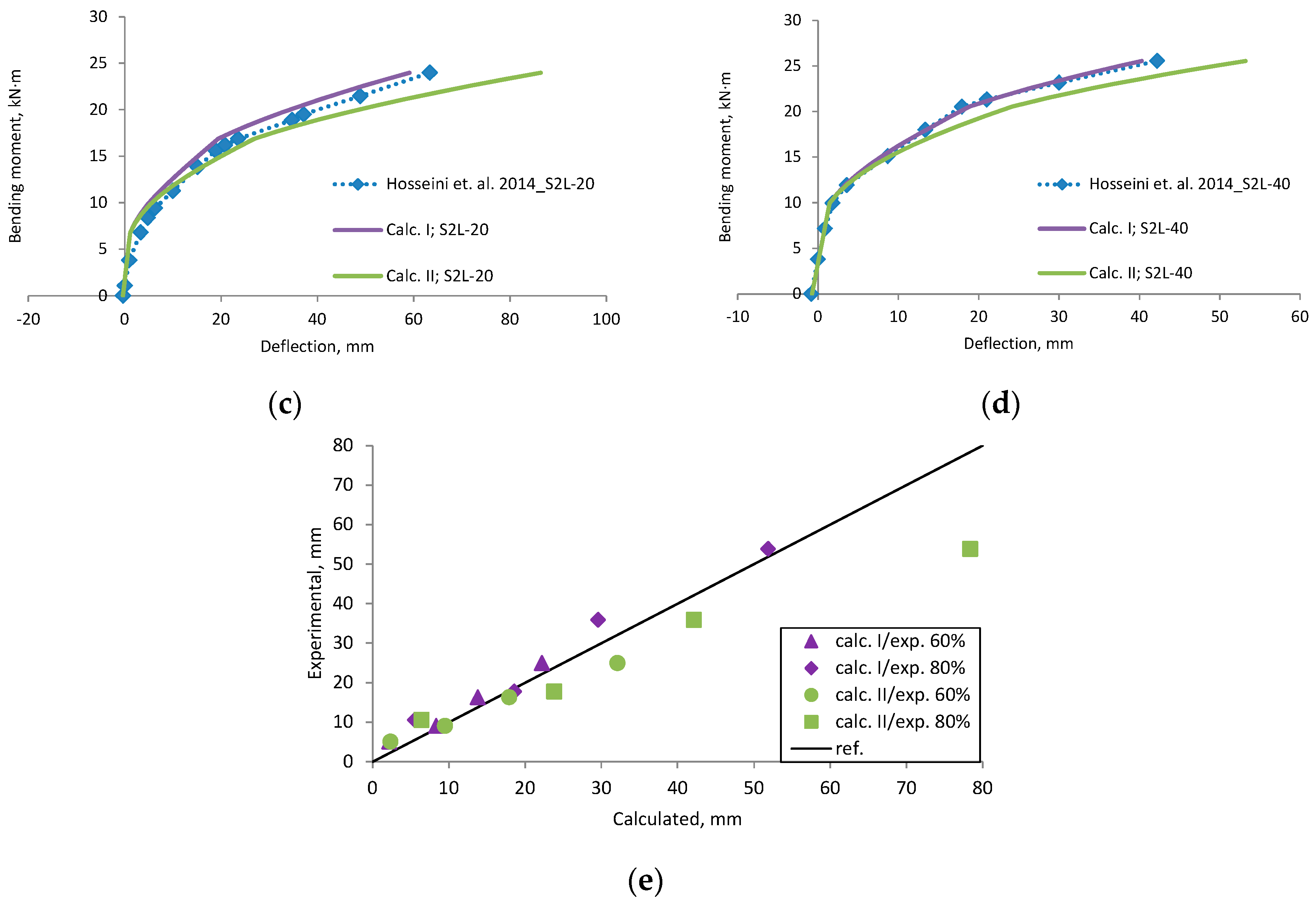

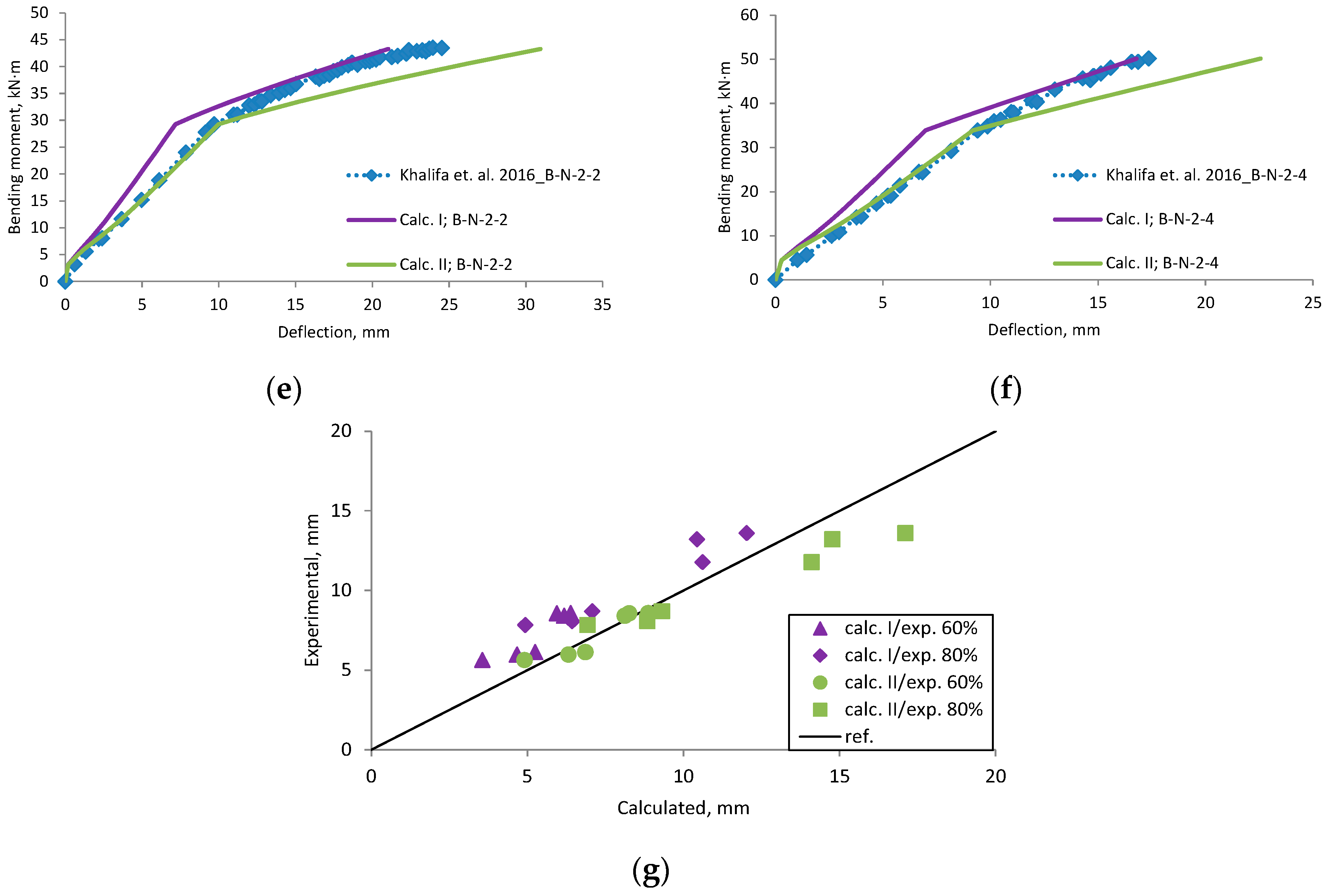
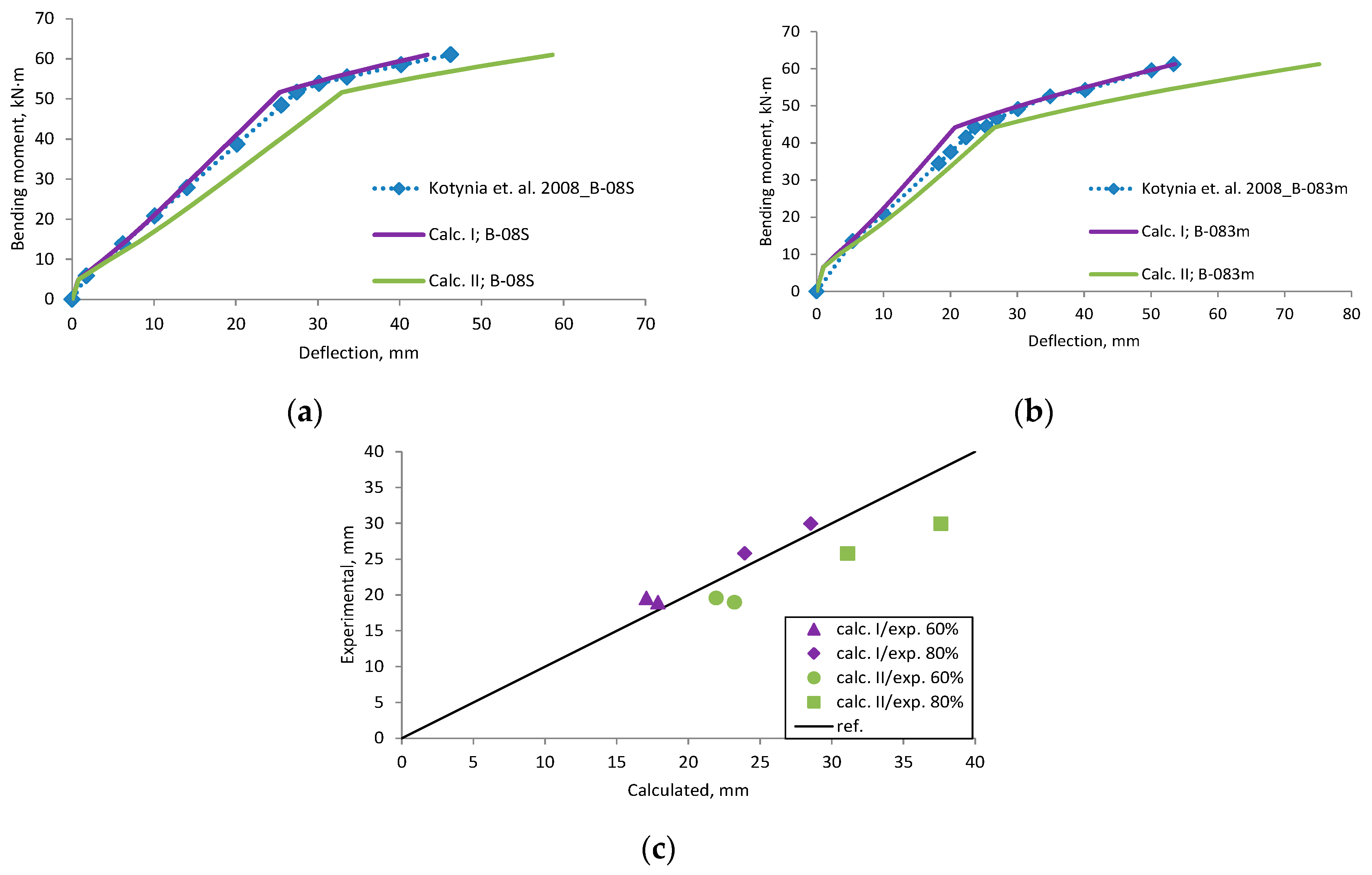


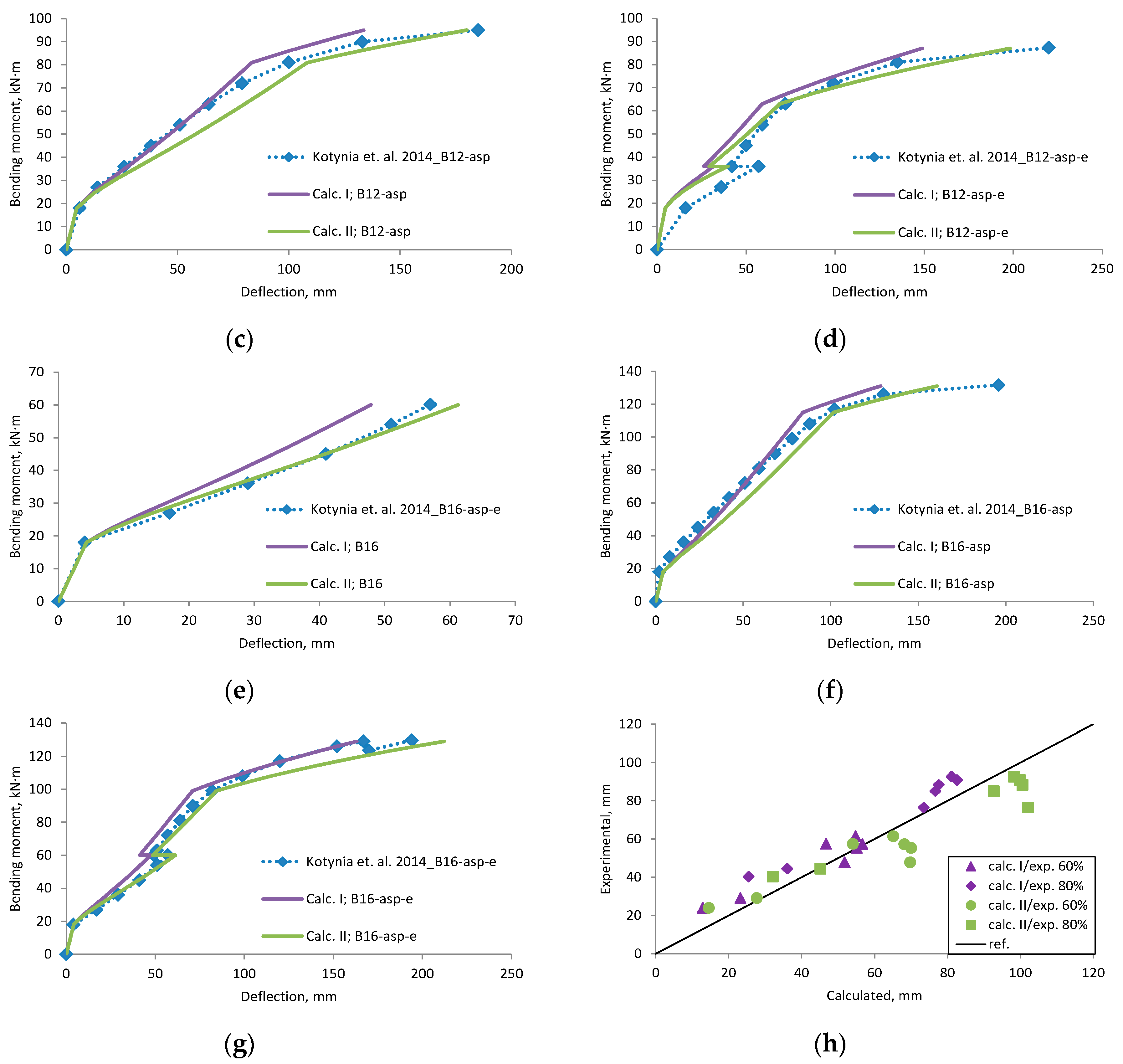

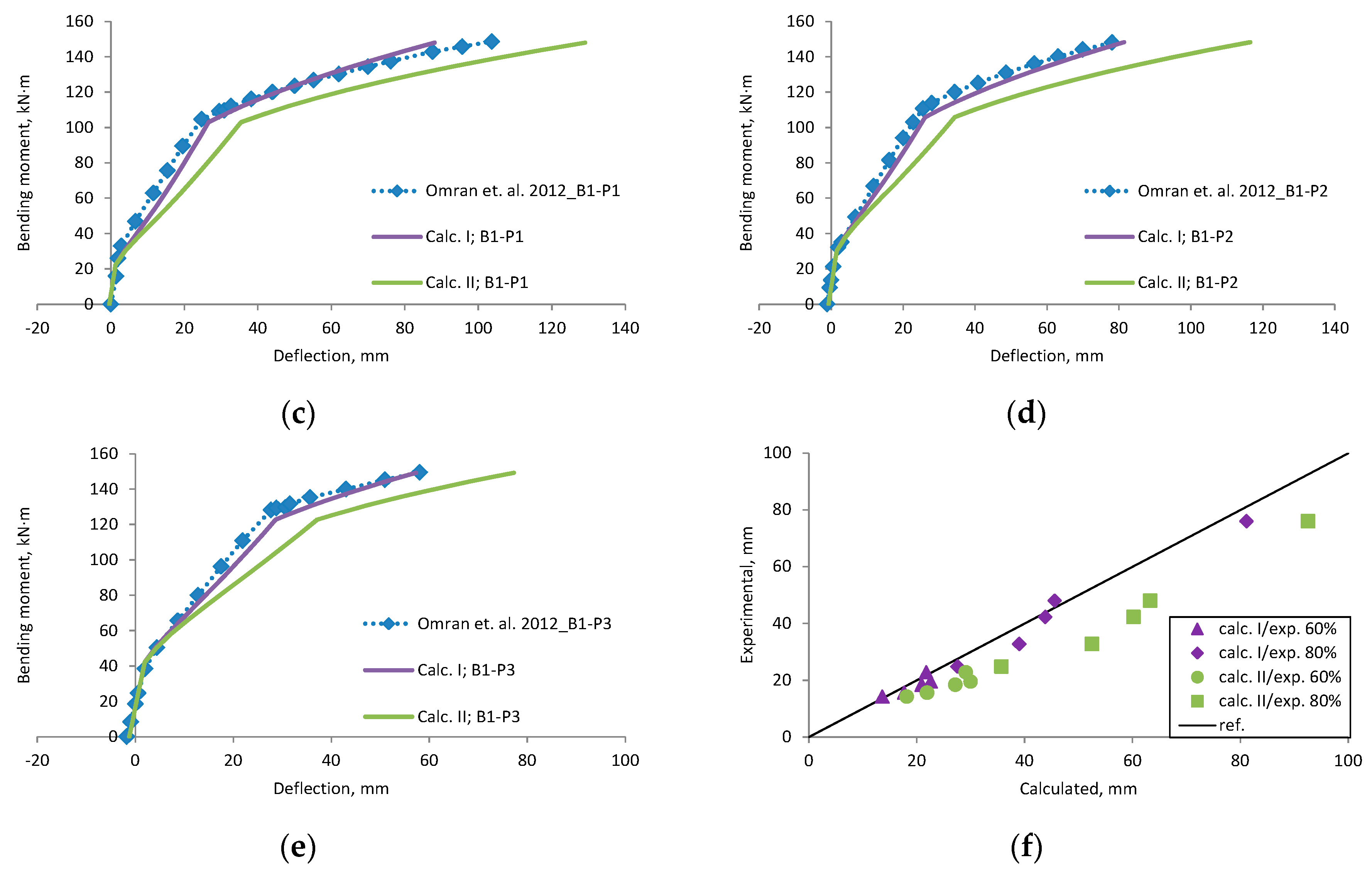
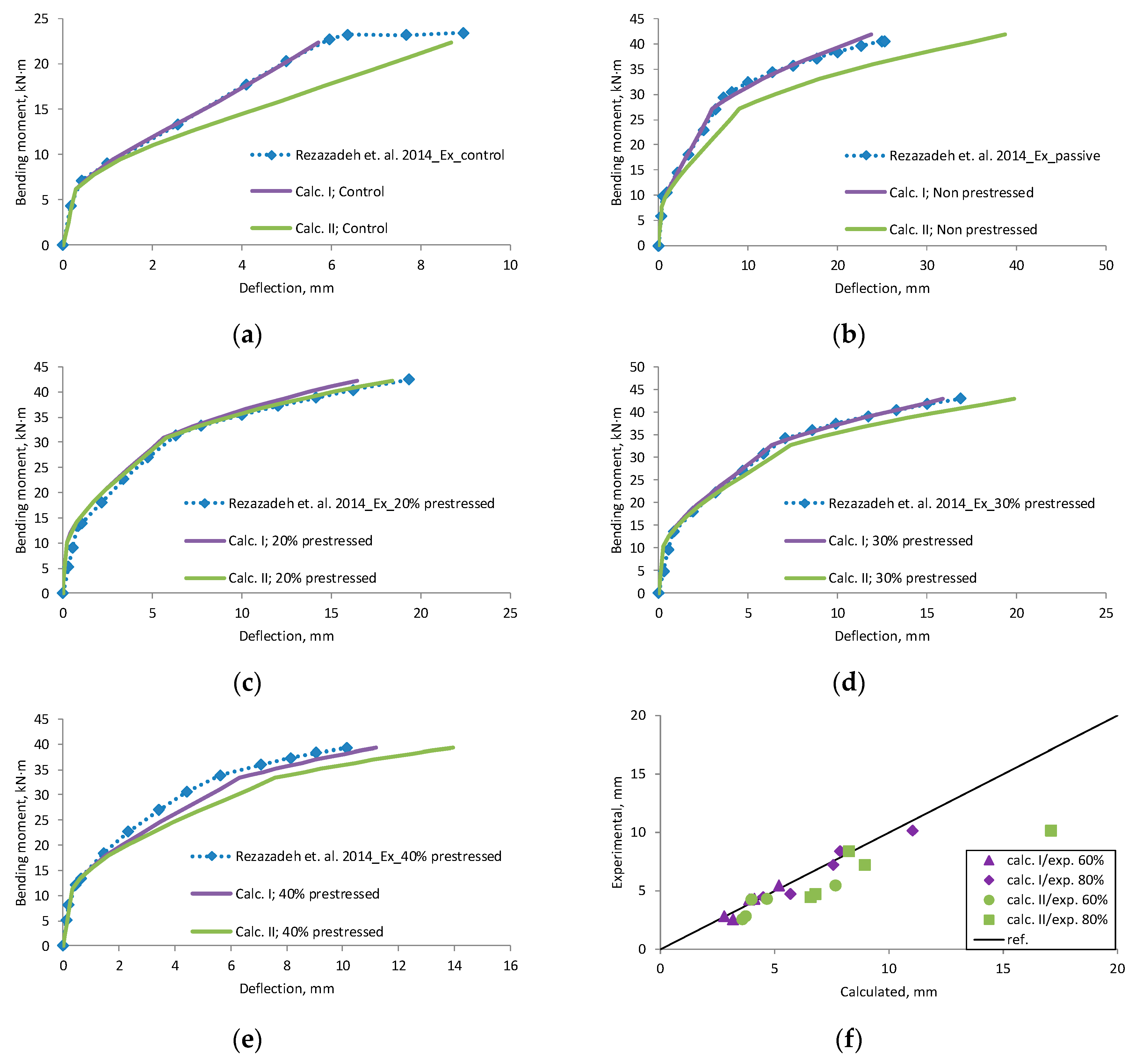
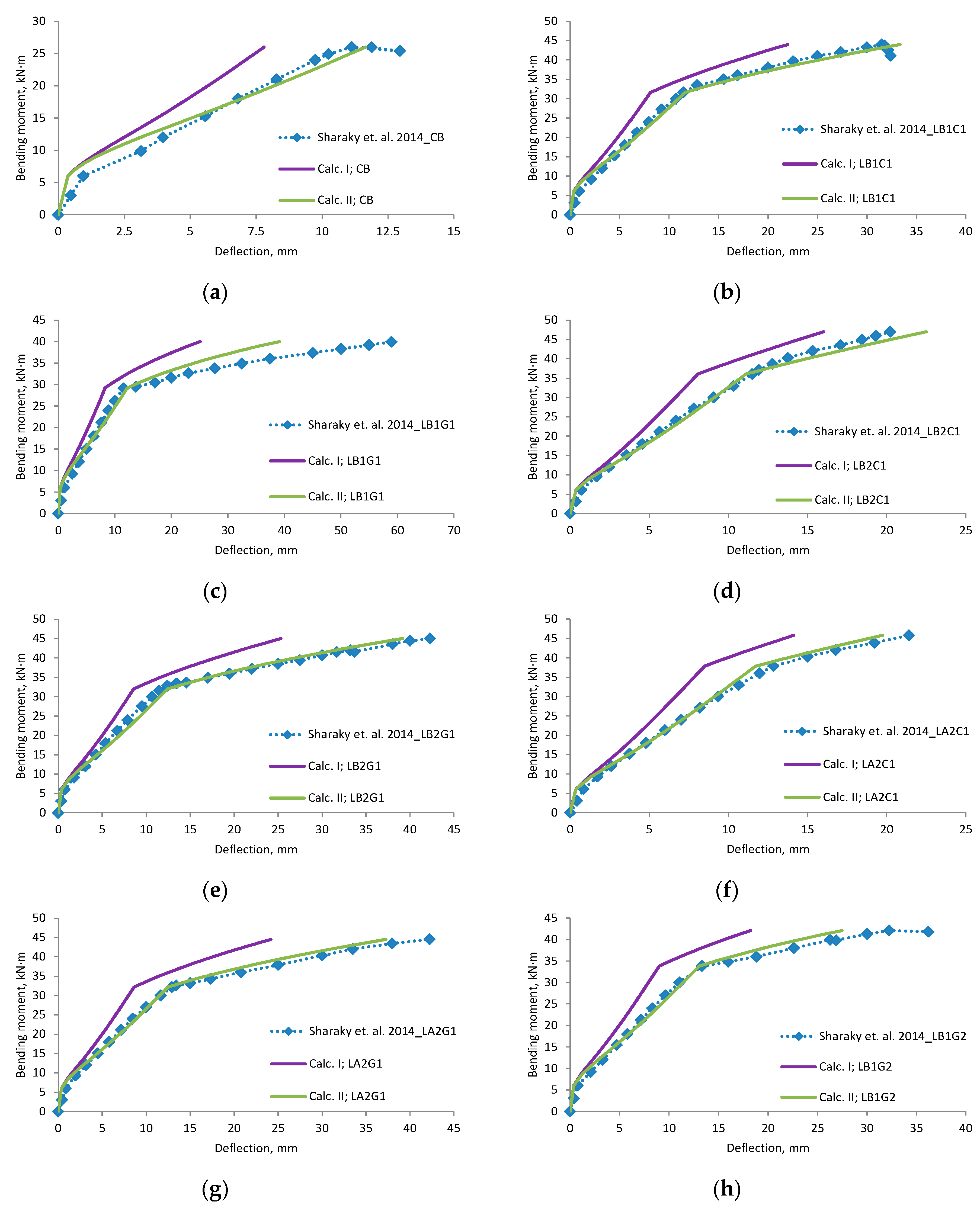
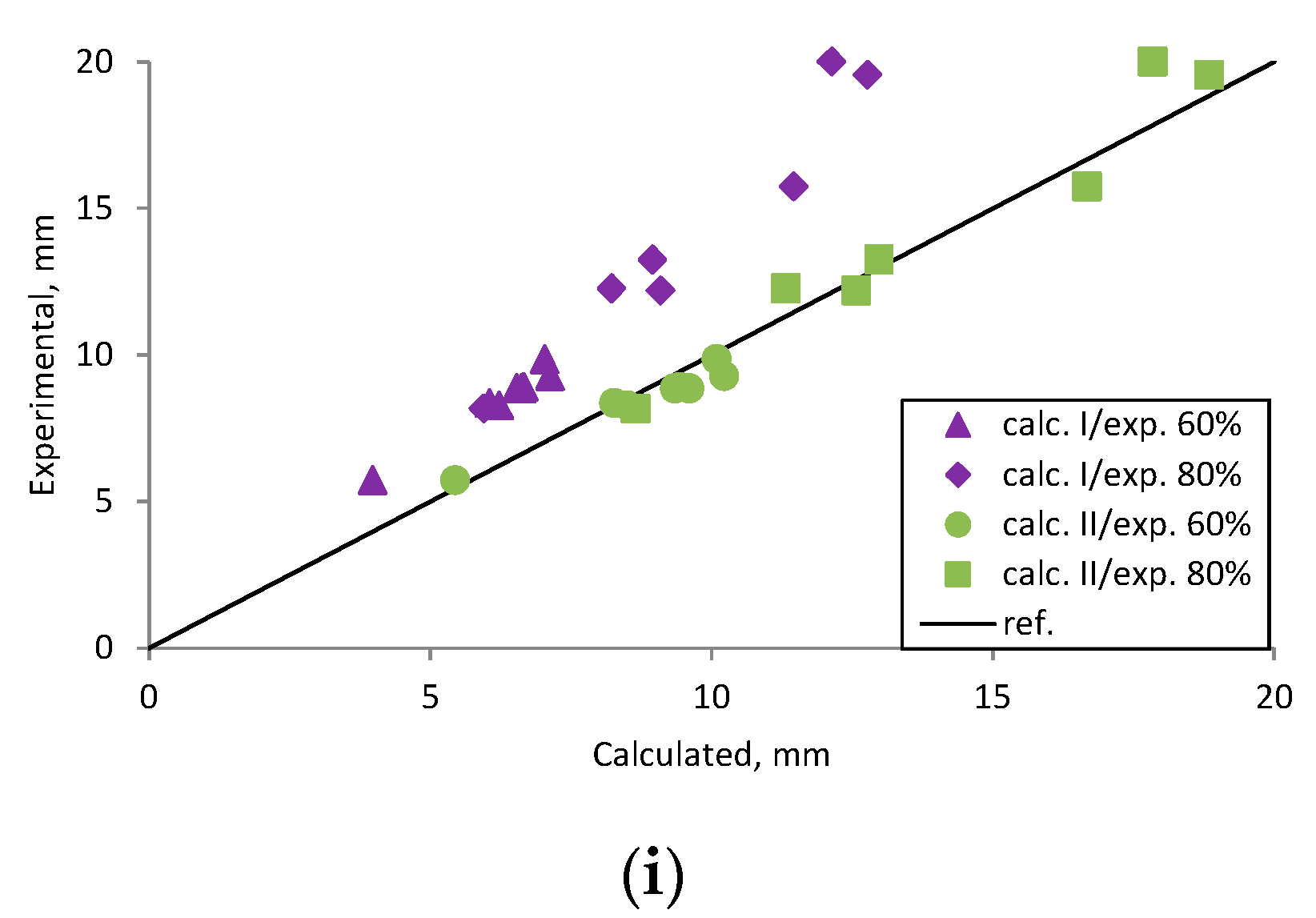


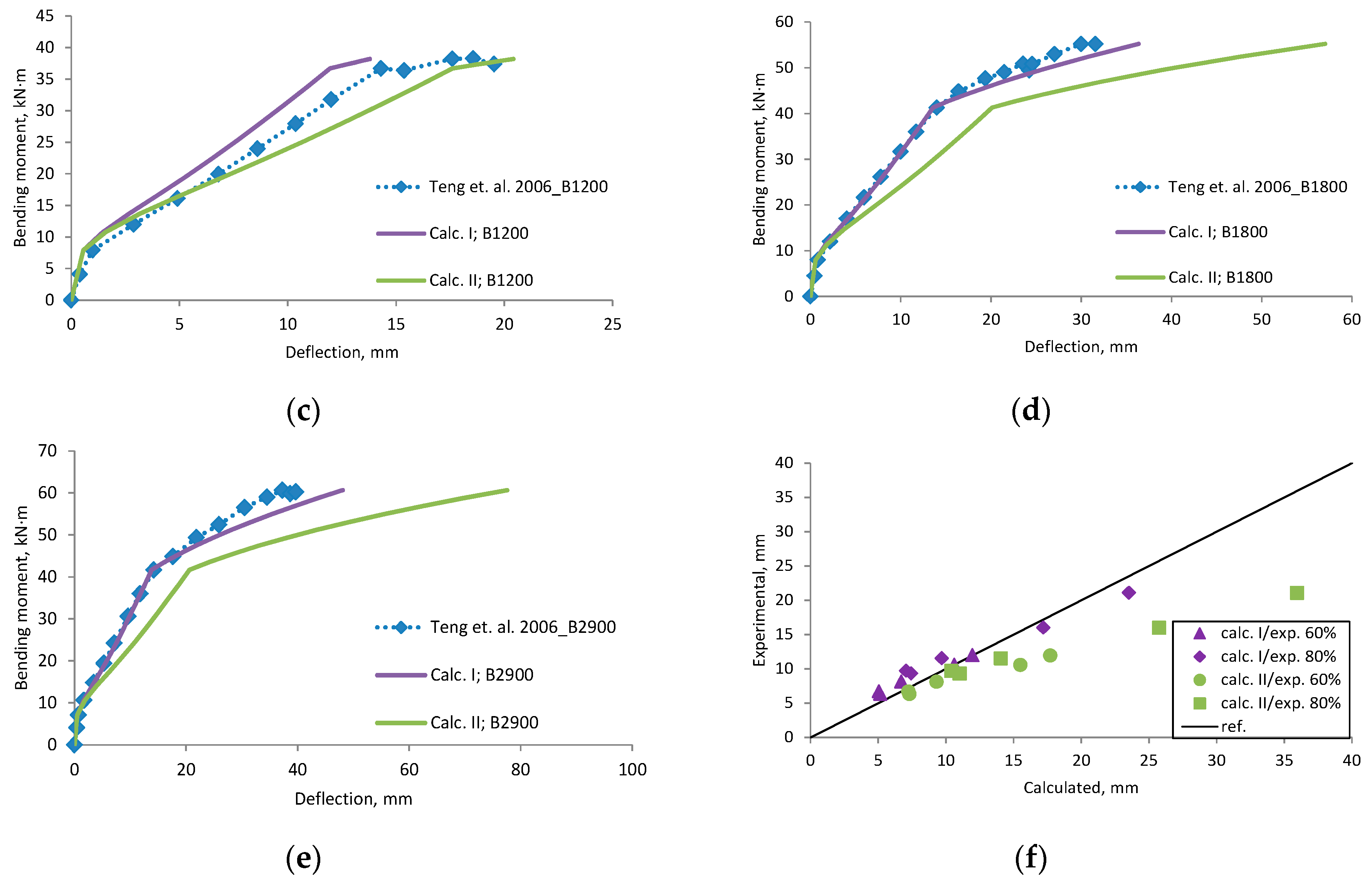
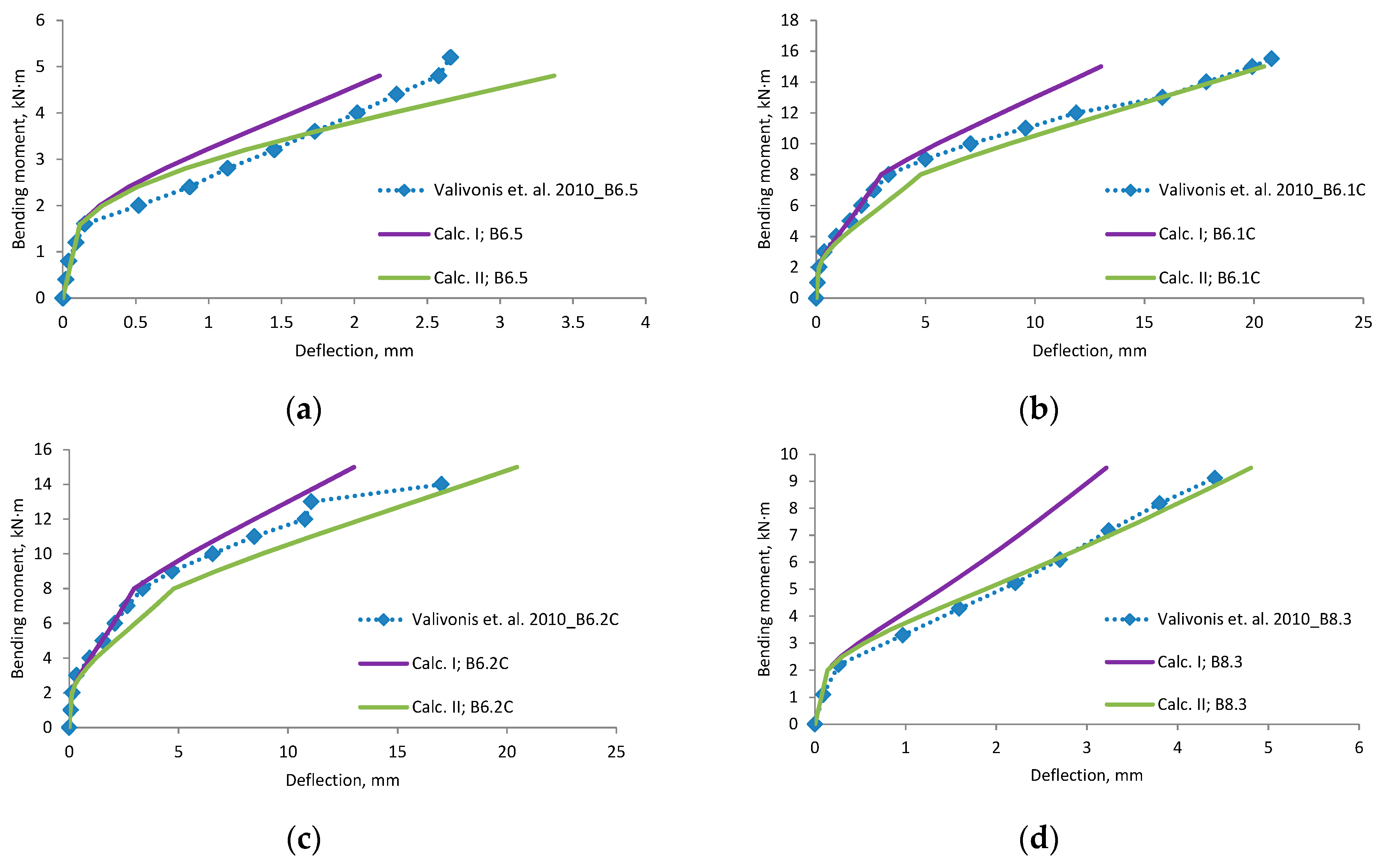
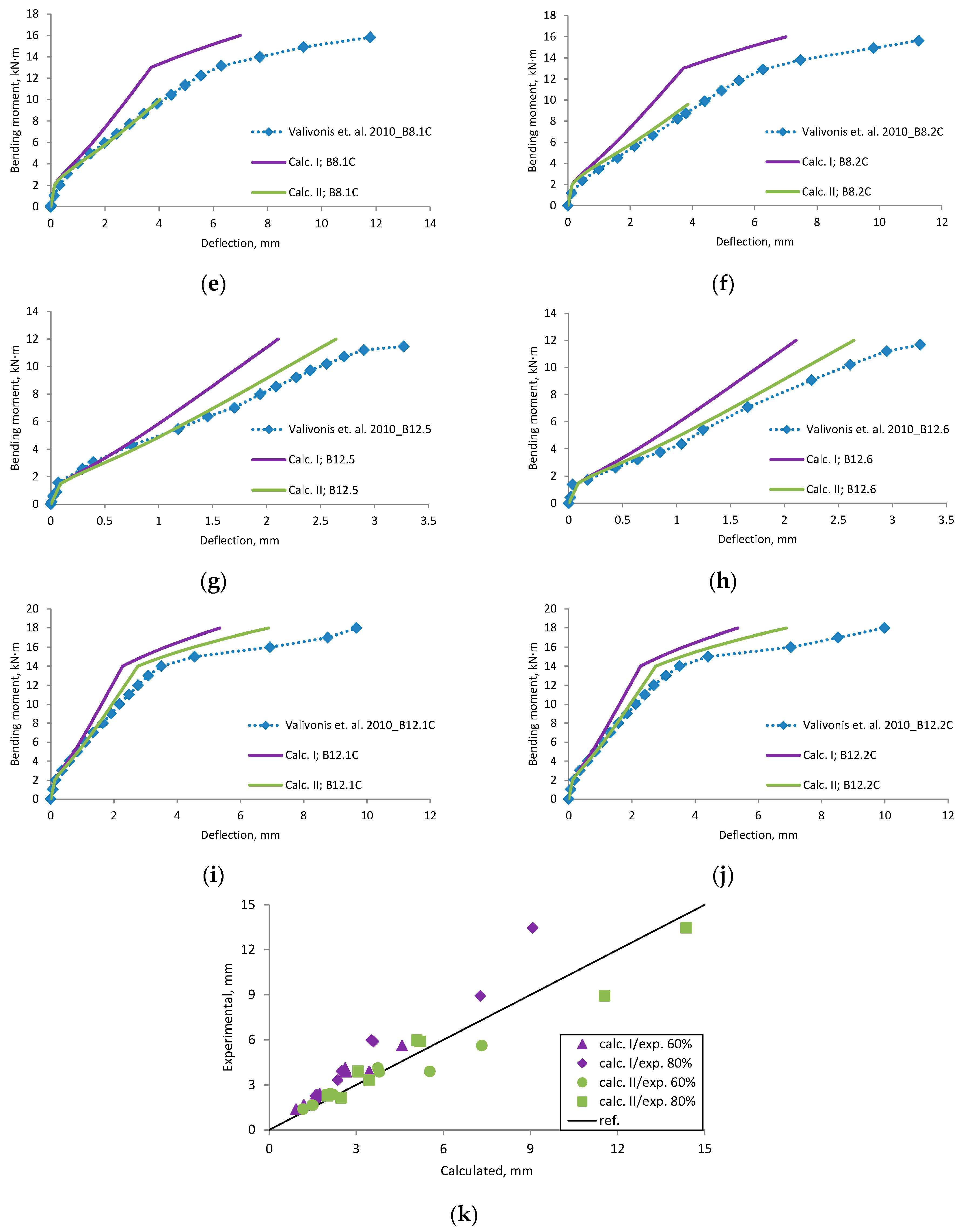

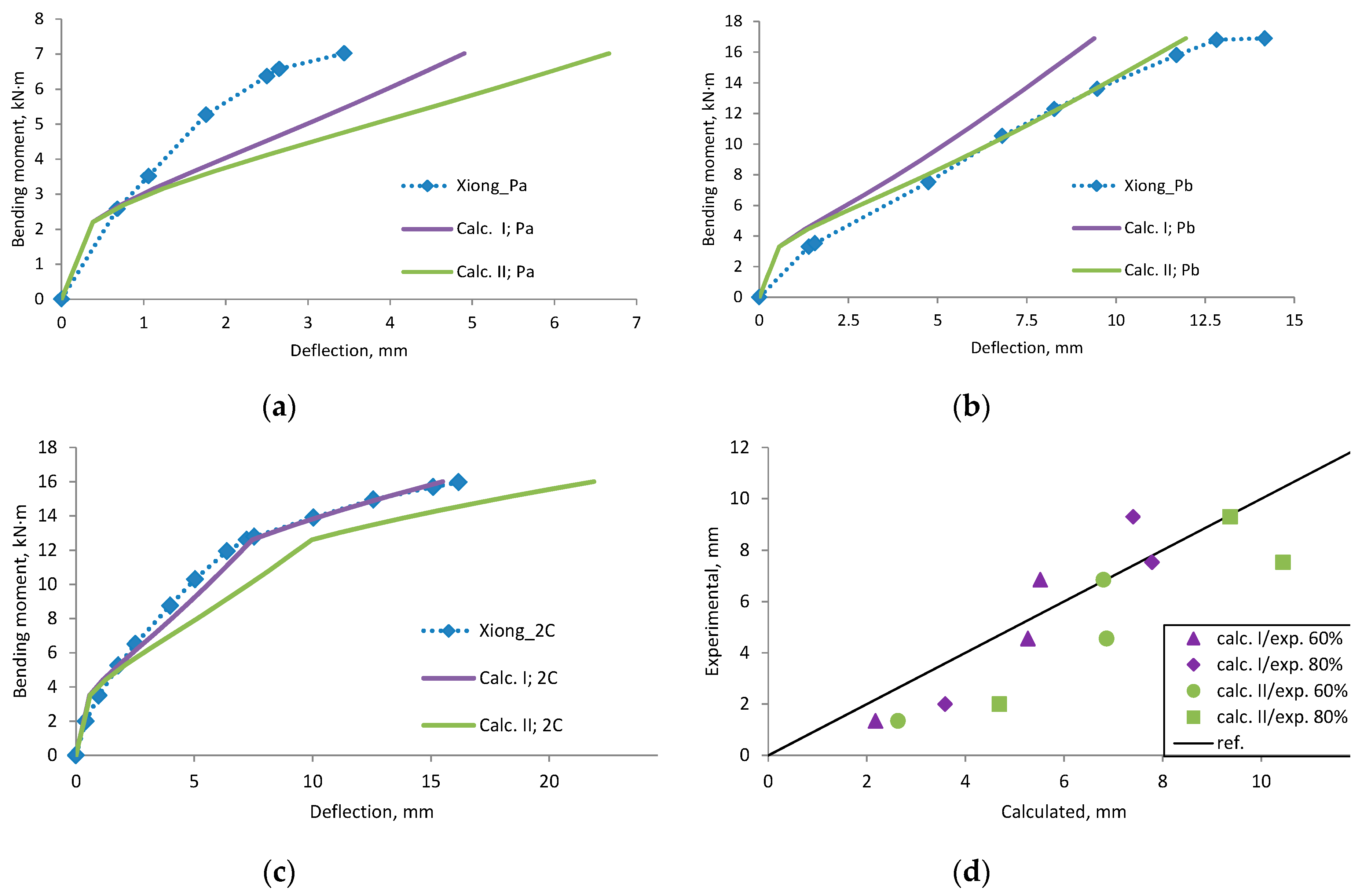
References
- Skuturna, T.; Valivonis, J.; Vainiūnas, P.; Marčiukaitis, G.; Daugevičius, M. Analysis of deflections of bridge girders strengthened by carbon fibre reinforcement. Balt. J. Road Bridge Eng. 2008, 3, 145–151. [Google Scholar] [CrossRef]
- Daugevičius, M.; Valivonis, J.; Marčiukaitis, G. Deflection analysis of reinforced concrete beams strengthened with carbon fibre reinforced polymer under long-term load action. J. Zhejiang Univ.-Sci. A (Appl. Phys. Eng.) 2012, 13, 571–583. [Google Scholar]
- Skuturna, T.; Valivonis, J. The statistical evaluation of design methods of the load-carrying capacity of flexural reinforced concrete elements strengthened with FRP. Arch. Civ. Mech. Eng. 2015, 15, 214–222. [Google Scholar] [CrossRef]
- Skuturna, T.; Valivonis, J. Experimental study on the effect of anchorage systems on RC beams strengthened using FRP. Compos. Part B 2016, 91, 283–290. [Google Scholar] [CrossRef]
- Skuturna, T.; Valivonis, J. Evaluation of calculation methods used for estimating the ultimate moment resistance of bridge decks reinforced with FRP bars. Balt. J. Road Bridge Eng. 2016, 11, 22–34. [Google Scholar] [CrossRef]
- Eslami, A.; Ronagh, H.R.; Mostofinejad, D. Analytical Assessment of CFRP Retrofitted Reinforced-Concrete Buildings Subjected to Near-Fault Ground Motions. J. Perform. Constr. Facil. 2016. [Google Scholar] [CrossRef]
- Al-Rousan, R.; Issa, M. Fatigue performance of reinforced concrete beams strengthened with CFRP sheets. Constr. Build. Mater. 2011, 25, 3520–3529. [Google Scholar] [CrossRef]
- Attari, N.; Amziane, S.; Chemrouk, M. Flexural strengthening of concrete beams using CFRP, GFRP and hybrid FRP sheets. Constr. Build. Mater. 2012, 37, 746–757. [Google Scholar] [CrossRef]
- Li, X.; Gu, X.; Song, X.; Ouyang, Y.; Feng, Z. Contribution of U-shaped strips to the flexural capacity of low-strength reinforced concrete beams strengthened with carbon fibre composite sheets. Compos. Part B 2013, 45, 117–126. [Google Scholar] [CrossRef]
- Charalambidi, B.G.; Rousakis, T.C.; Karabinis, A.I. Analysis of the fatigue behavior of reinforced concrete beams strengthened in flexure with fiber reinforced polymer laminates. Compos. Part B 2016, 96, 69–78. [Google Scholar] [CrossRef]
- Triantafyllou, G.G.; Rousakis, T.C.; Karabinis, A.I. Corroded RC beams patch repaired and strengthened in flexure with fiber-reinforced polymer laminates. Compos. Part B 2017, 112, 125–136. [Google Scholar] [CrossRef]
- Charalambidi, B.G.; Rousakis, T.C.; Karabinis, A.I. Fatigue Behavior of Large-Scale Reinforced Concrete Beams Strengthened in Flexure with Fiber-Reinforced Polymer Laminates. J. Compos. Constr. 2016, 20. [Google Scholar] [CrossRef]
- Zhang, S.S.; Yu, T.; Chen, G.M. Reinforced concrete beams strengthened in flexure with near-surface mounted (NSM) CFRP strips: Current status and research needs. Compos. Part B 2017, 131, 30–42. [Google Scholar] [CrossRef]
- Valivonis, J.; Skuturna, T.; Daugevičius, M. The load-carrying capacity of reinforced concrete beams strengthened with carbon fibre composite in the tension zone subjected to temporary or sustained load. In Proceedings of the 10th International Conference on Modern Building Materials. Structures and Techniques, Vilnius, Lithuania, 19–21 May 2010; pp. 818–825. [Google Scholar]
- Hawileh, R.A. Nonlinear finite element modelling of RC beams strengthened with NSM FRP rods. Constr. Build. Mater. 2012, 27, 461–471. [Google Scholar] [CrossRef]
- ACI Committee 318. Building Code Requirement for Structural Concrete; American Concrete Institute: Farmington Hills, MI, USA, 2002. [Google Scholar]
- Eurocode 2: Design of Concrete Structures—Part 1: General Rules and Rules for Buildings; European Committee for Standardization: Brussels, Belgium, 2004.
- Paththini, M.M.; Burgoyne, A.; Burgoyne, C. Moment-Curvature and Strain energy of Beams with External Fiber-Reinforced Polymer Reinforcement. ACI Struct. J. 2009, 106, 20–29. [Google Scholar]
- Yinghao, L.; Yong, Y. Arrangement of hybrid rebars on flexural behavior of HSC beams. Compos. Part B 2013, 45, 22–31. [Google Scholar] [CrossRef]
- Guan, G.X.; Burgoyne, C.J. Comparison of Moment-Curvature Models for Fiber-Reinforced Polymer Plate-End Debonding Studies Using Global Energy Balance Approach. ACI Struct. J. 2014, 111, 27–36. [Google Scholar]
- Rezazadeh, M.; Barros, J.; Costa, L. Analytical approach for flexural analysis of RC beams strengthened with prestressed CFRP. Compos. Part B 2015, 73, 16–34. [Google Scholar] [CrossRef]
- Smith, S.T.; Kim, S.J. Deflection Calculation of Frp-Strengthened Reinforced Concrete Flexural Members. Aust. J. Struct. Eng. 2010, 11, 75–86. [Google Scholar] [CrossRef]
- Smith, S.T.; Rasheed, H.A.; Kim, S.J. Moment-Curvature Based Modeling of FRP-Strengthened RC Members Anchored with FRP Anchors. In Proceedings of the APFIS, Singapore, 19–21 July 2017. [Google Scholar]
- Barros, J.A.O.; Fortes, A.S. Flexural strengthening of concrete beams with CFRP laminates bonded into slits. Cem. Concr. Compos. 2005, 27, 471–480. [Google Scholar] [CrossRef]
- Bilotta, A.; Ceroni, F.; Nigro, E.; Pecce, M. Efficiency of CFRP NSM strips and EBR plates for flexural strengthening of RC beams and loading pattern influence. Compos. Struct. 2015, 124, 163–175. [Google Scholar] [CrossRef]
- David, E.; Ragneau, E.; Buyle-Bodin, E. Experimental analysis of flexural behaviour of externally bonded CFRP reinforced concrete structures. Mater. Struct. 2003, 36, 238–241. [Google Scholar] [CrossRef]
- El-Gamal, S.E.; Al-Nuaimi, A. Efficiency of near surface mounted technique using fiber reinforced polymers for the flexural strengthening of RC beams. Constr. Build. Mater. 2016, 118, 52–62. [Google Scholar] [CrossRef]
- Ferrier, E.; Avril, A.; Hamelin, P.; Vautrin, A. Mechanical behavior of RC beams reinforced by externally bonded CFRP sheets. Mater. Struct. 2003, 36, 522–529. [Google Scholar] [CrossRef]
- Gao, B.; Kim, J.K.; Leung, C.K.Y. Experimental study on RC beams with FRP strips bonded with rubber modified resins. Compos. Sci. Technol. 2004, 64, 2557–2564. [Google Scholar] [CrossRef]
- Gao, B.; Kim, J.K.; Leung, C.K.Y. Strengthening efficiency of taper ended FRP strips bonded to RC beams. Compos. Sci. Technol. 2006, 66, 2257–2264. [Google Scholar] [CrossRef]
- Heffernan, P.J. Fatigue behaviour of reinforced concrete beams strengthened with CFRP laminates. Ph.D. Thesis, Department of Civil engineering Royal Military College of Canada, Kingston, ON, Canada, May 1997. [Google Scholar]
- Heffernan, P.J.; Erki, M.A. Fatigue Behavior of Reinforced Concrete Beams Strengthened with Carbon Fiber Reinforced Plastic Laminates. J. Compos. Constr. 2004, 8, 132–140. [Google Scholar] [CrossRef]
- Hosseini, M.R.M.; Dias, S.J.E.; Barros, J.A.O. Effectiveness of prestressed NSM CFRP laminates for the flexural strengthening of RC slabs. Compos. Struct. 2014, 111, 249–258. [Google Scholar] [CrossRef]
- Khalifa, A.M. Flexural performance of RC beams Strengthened with near surface mounted CFRP strips. Alex. Eng. J. 2016, 55, 1497–1505. [Google Scholar] [CrossRef]
- Kotynia, R.; Baky, H.A.; Neale, K.W.; Ebead, U.A. Flexural Strengthening of RC Beams with Externally Bonded CFRP Systems: Test Results and 3D Nonlinear FE Analysis. J. Compos. Constr. 2008, 12, 190–201. [Google Scholar] [CrossRef]
- Kotynia, R.; Walenziak, R.; Stoecklin, I.; Meier, U. RC Slabs Strengthened with Prestressed and Gradually Anchored CFRP Strips under Monotonic and Cyclic Loading. J. Compos. Constr. 2011, 15, 168–180. [Google Scholar] [CrossRef]
- Kotynia, R.; Lasek, K.; Staskiewicz, M. Flexural Behavior of Preloaded RC Slabs Strengthened with Prestressed CFRP Laminates. J. Compos. Constr. 2014, 18, A4013004. [Google Scholar] [CrossRef]
- Omran, H.Y.; El-Hacha, R. Nonlinear 3D finite element modeling of RC beams strengthened with prestressed NSM-CFRP strips. Constr. Build. Mater. 2012, 31, 74–85. [Google Scholar] [CrossRef]
- Rezazadeh, M.; Costa, I.; Barros, J. Influence of prestress level on NSM CFRP laminates for the flexural strengthening of RC beams. Compos. Struct. 2014, 116, 489–500. [Google Scholar] [CrossRef]
- Sharaky, I.A.; Torres, L.; Comas, J.; Barris, C. Flexural response of reinforced concrete (RC) beams strengthened with near surface mounted (NSM) fiber reinforced polymer (FRP) bars. Compos. Struct. 2014, 109, 8–22. [Google Scholar] [CrossRef]
- Soudki, K.; El-Salakawy, E.; Craig, B. Behavior of CFRP Strenghtened Rainforced Concrete Beams in Corosive Environment. J. Compos. Constr. 2007, 11, 291–298. [Google Scholar] [CrossRef]
- Teng, J.G.; De Lorenzis, L.; Wang, B.; Li, R.; Wong, T.N.; Lam, L. Debonding Failures of RC Beams Strengthened with Near Surface Mounted CFRP Strips. J. Compos. Constr. 2006, 10, 92–105. [Google Scholar] [CrossRef]
- Wu, G.; Dong, Z.Q.; Wu, Z.S.; Zhang, L.W. Performance and Parametric Analysis of Flexural Strengthening for RC Beams with NSM-CFRP Bars. J. Compos. Constr. 2014. [Google Scholar] [CrossRef]
- Xiong, G.J.; Jiang, X.; Liu, J.W.; Chen, L. A way for preventing tension delamination of concrete cover in midspan of FRP strengthened beams. Constr. Build. Mater. 2007, 21, 402–408. [Google Scholar] [CrossRef]
- Branson, D.E. Deformation of Concrete Structures; McGraw-Hill: New York, NY, USA, 1977. [Google Scholar]
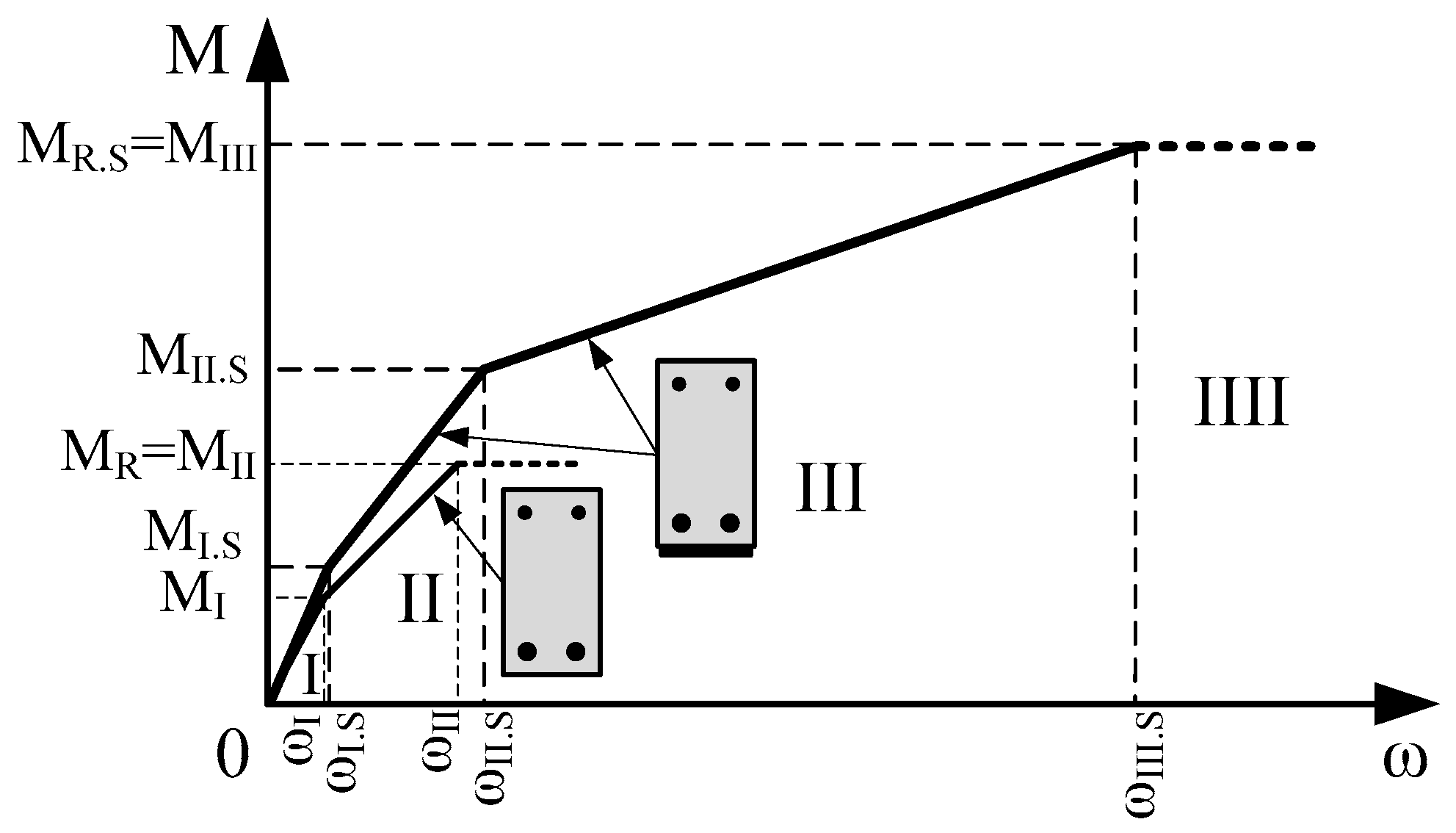
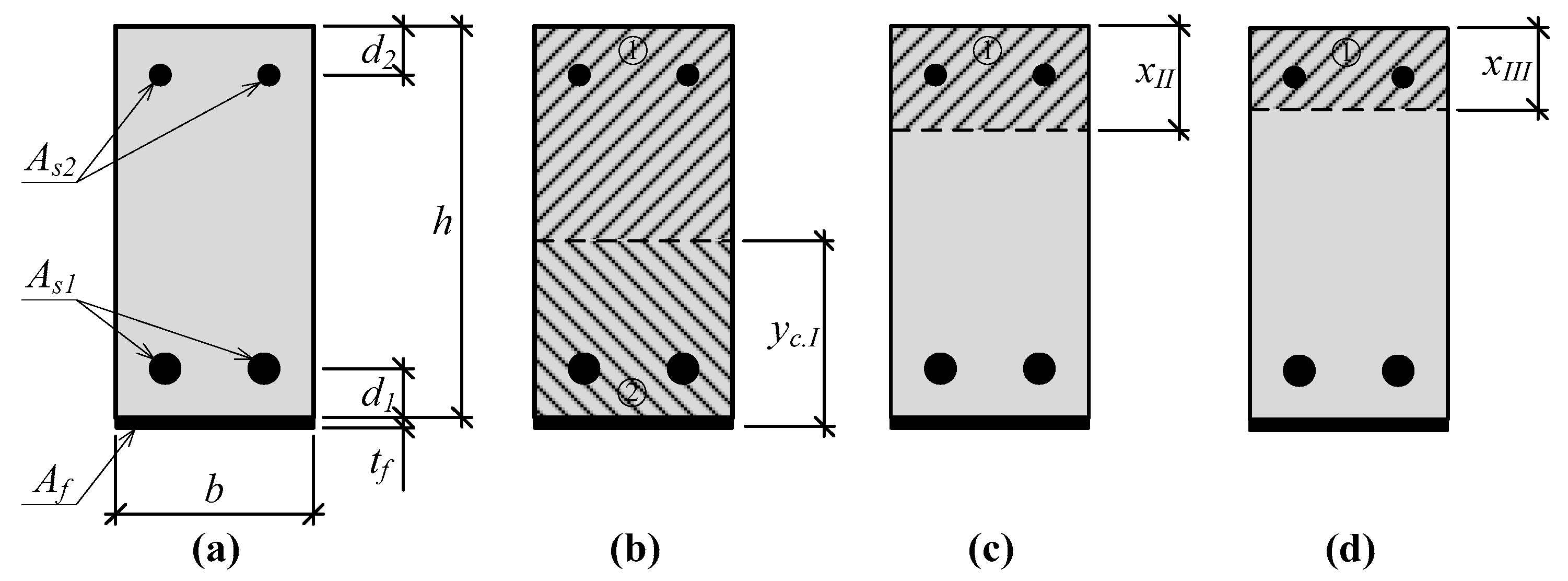
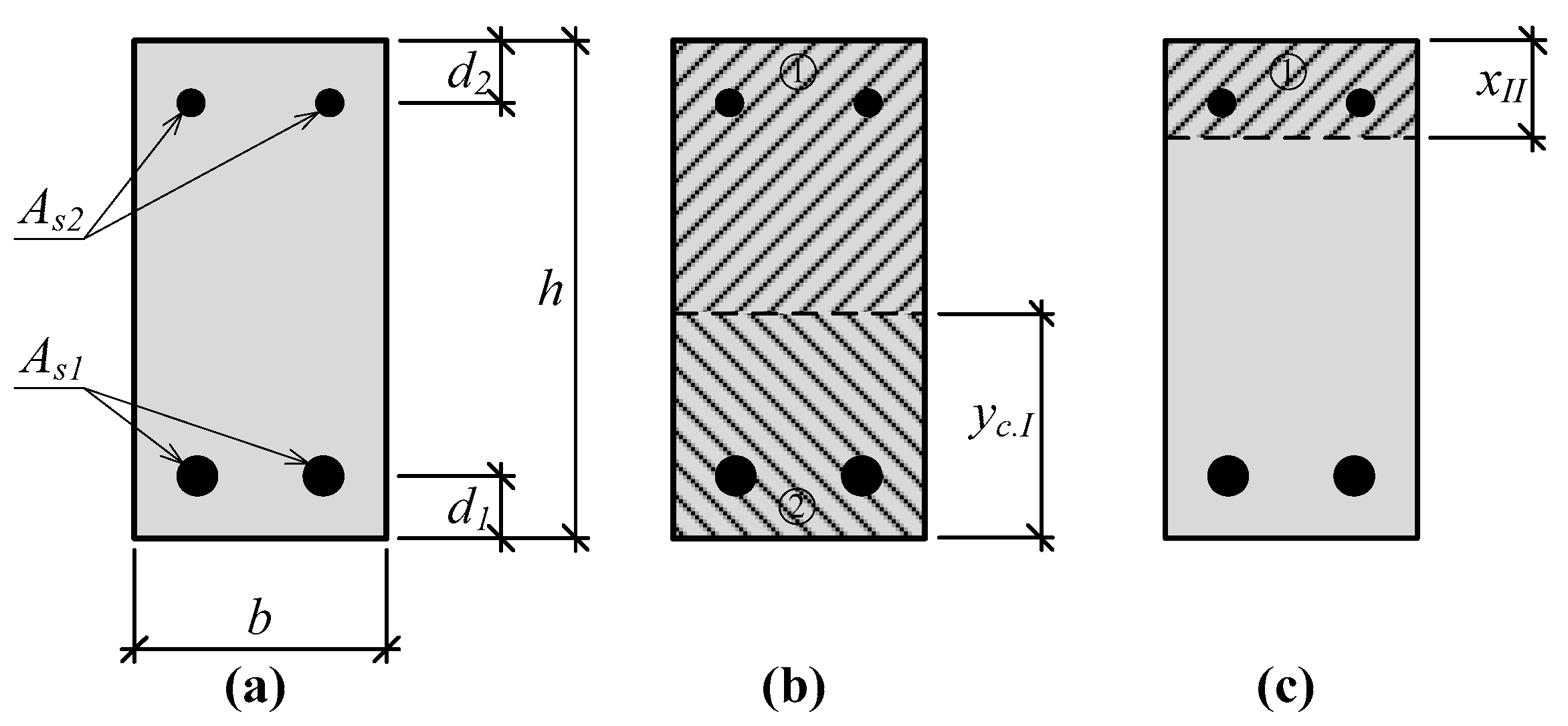
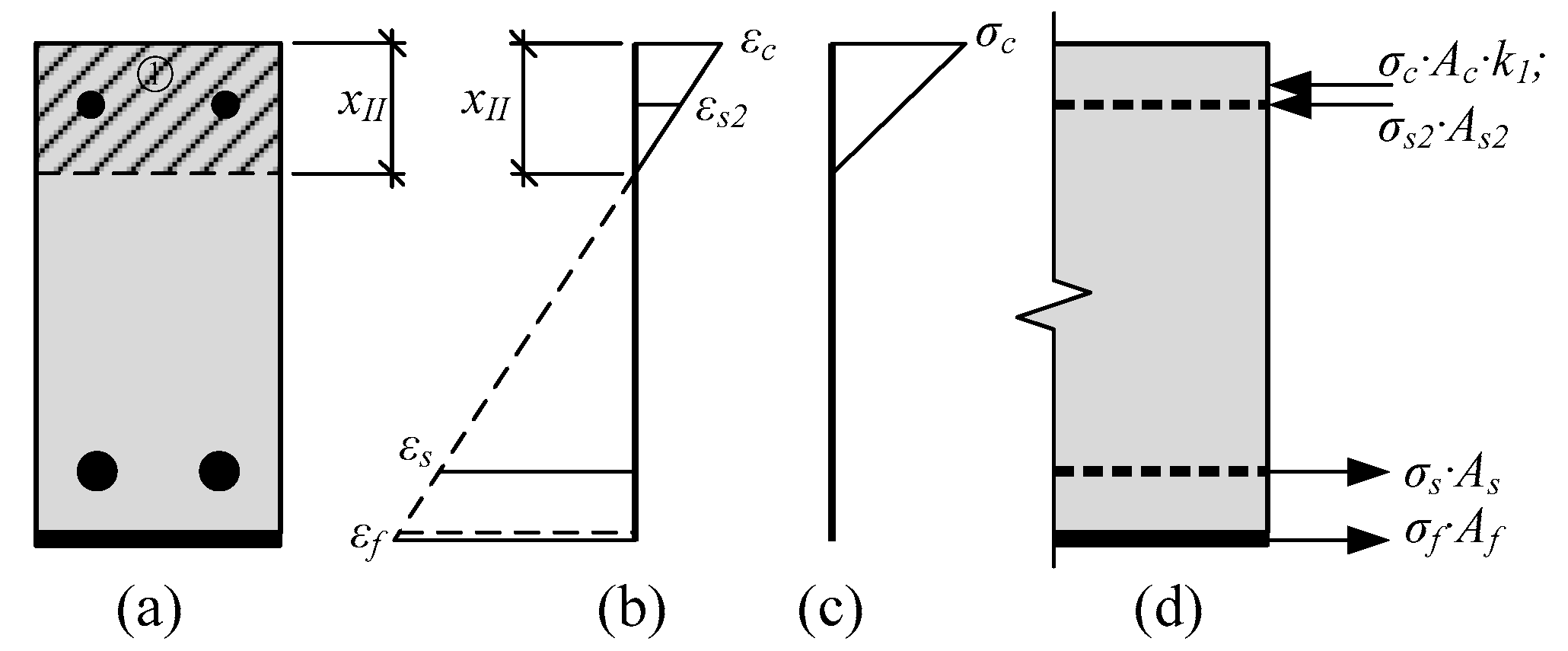
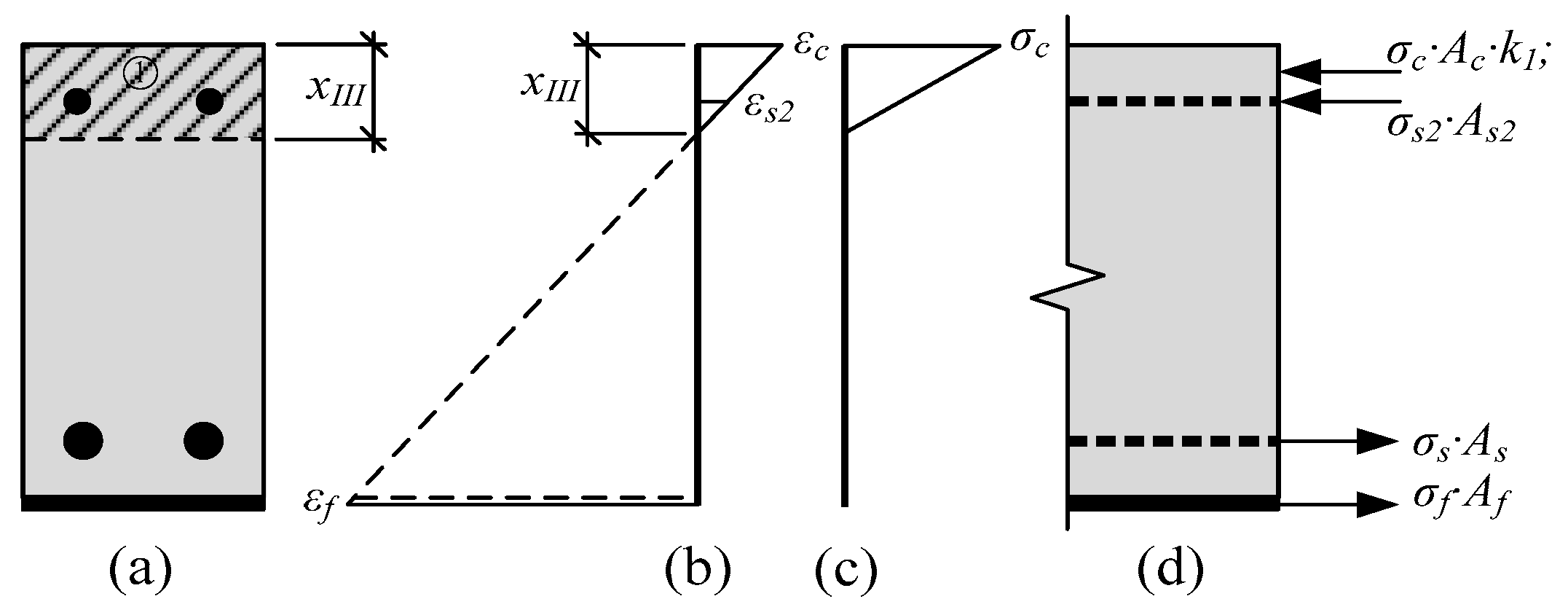
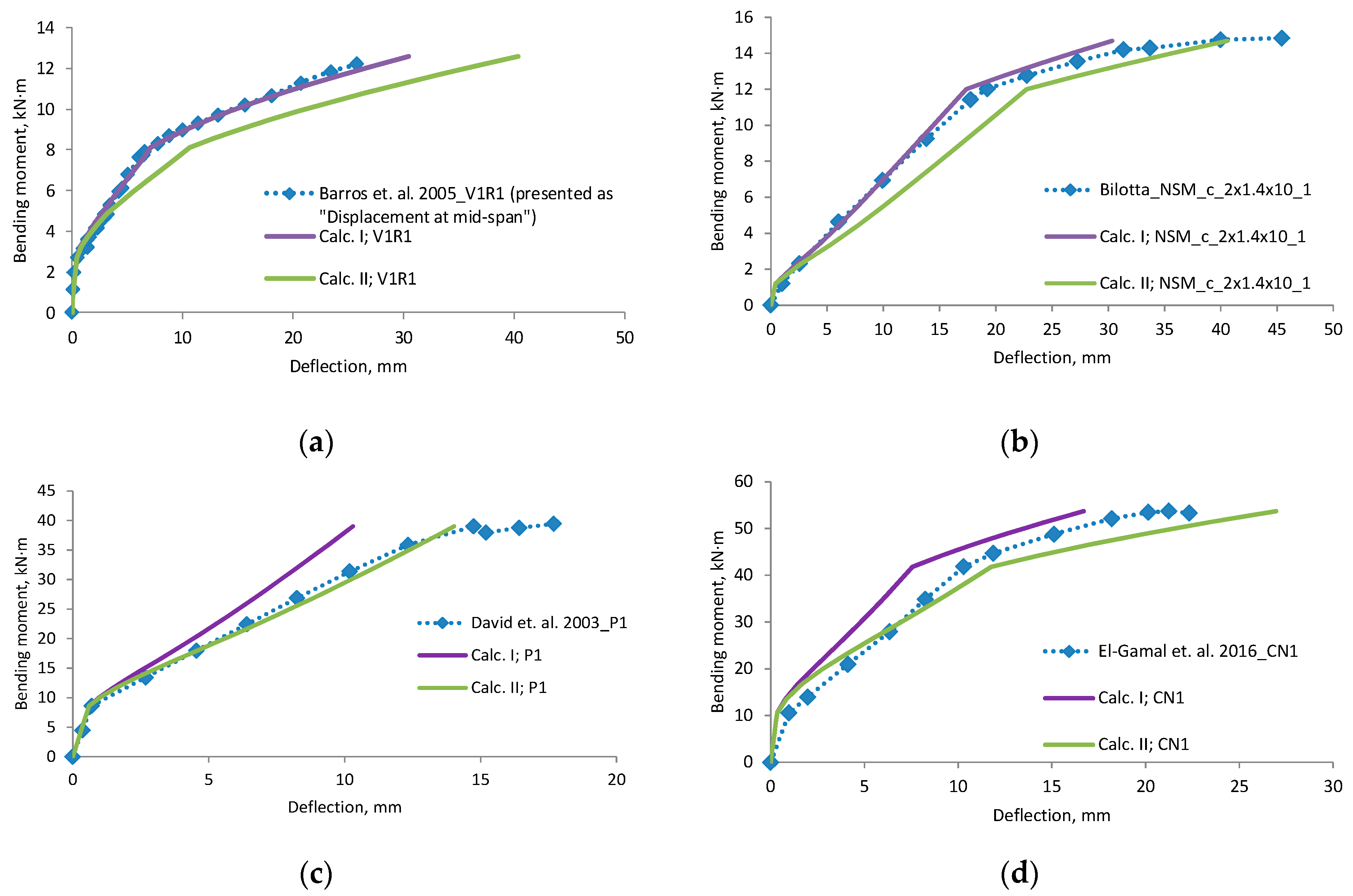
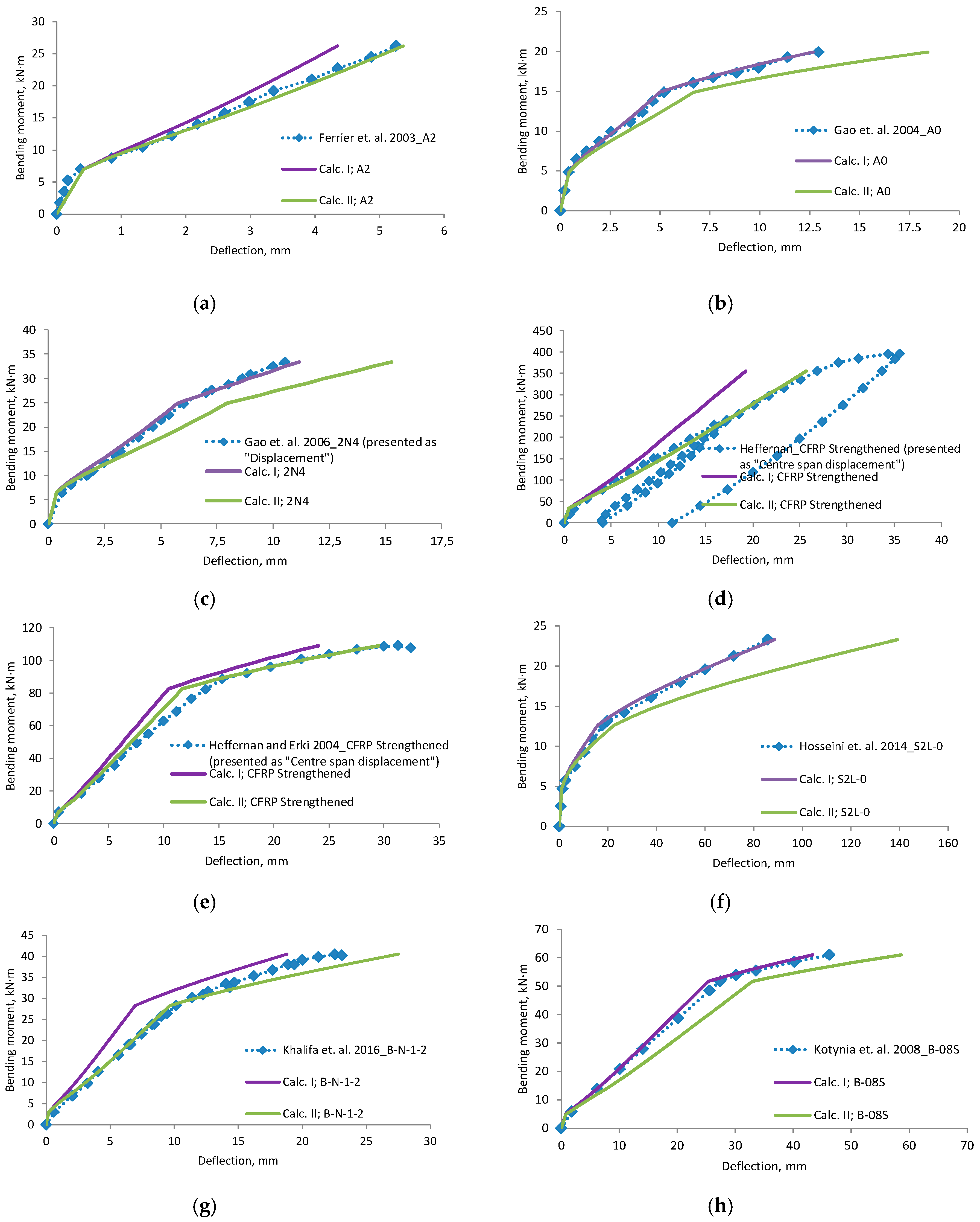

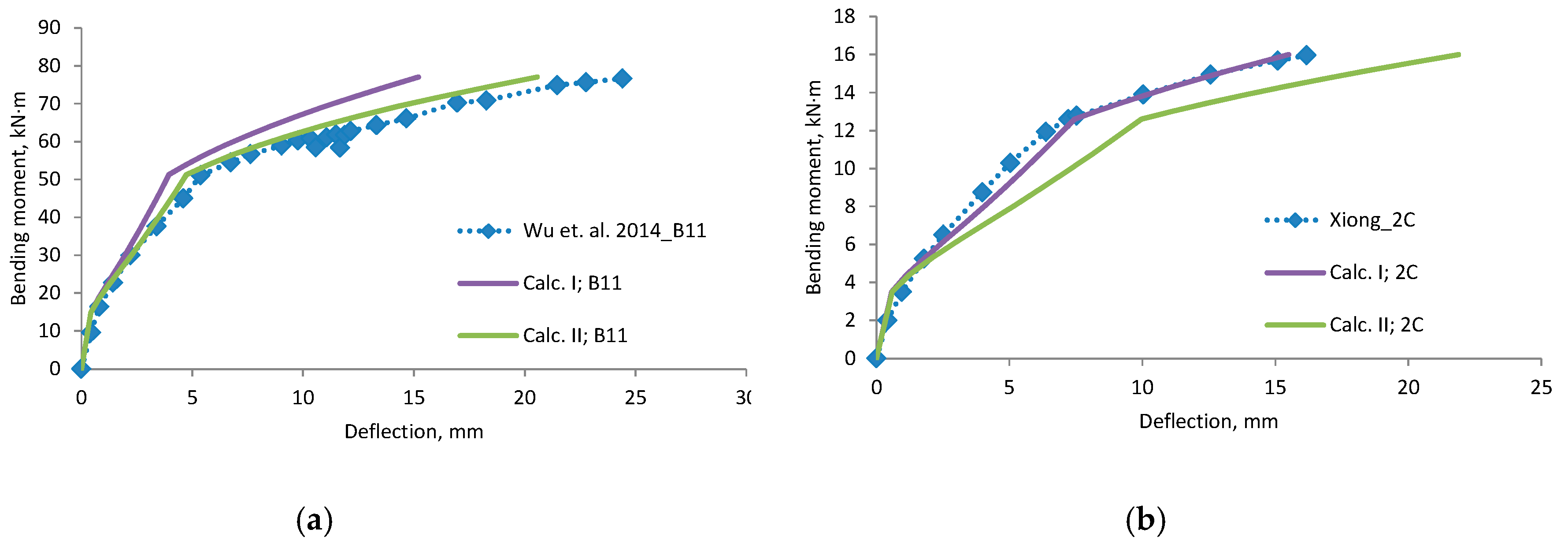
| Author | Beam Name | l, m | Load Positions, m | b, m | h, m | As1 | As2 | d1, m | d2, m | Af |
|---|---|---|---|---|---|---|---|---|---|---|
| Barros et al., 2005 [24] | V1 | 1.5 | 0.5 + 0.5 + 0.5 | 0.1 | 0.178 | 2Ø6 | 2Ø8 | 0.024 | 0.025 | – |
| V1R1 | 0.17 | 2Ø6 | 1 × 1.45 × 9.59 | |||||||
| V2 | 0.173 | 3Ø6 | – | |||||||
| V2R2 | 0.177 | 3Ø6 | 2 × 1.45 × 9.59 | |||||||
| V3 | 0.175 | 2Ø6 | – | |||||||
| V3R2 | 0.175 | 2Ø6 + Ø8 | 2 × 1.45 × 9.59 | |||||||
| V4 | 0.175 | 3Ø8 | 0.025 | – | ||||||
| V4R3 | 0.18 | 3Ø8 | 3 × 1.45 × 9.59 | |||||||
| Bilotta et al., 2015 [25] | Ref_c_no_1 | 2.1 | 0.925 + 0.25 + 0.925 | 0.12 | 0.16 | 2Ø10 | 2Ø10 | 0.05 | 0.035 | – |
| Ref_d_no_1 | Distributed load | – | ||||||||
| EBR_c_1.4 × 40_1 | 0.925 + 0.25 + 0.925 | 56 mm2 | ||||||||
| EBR_c_1.4 × 40_2 | 56 mm2 | |||||||||
| EBR_d_1.4 × 40_1 | Distributed load | 56 mm2 | ||||||||
| EBR_d_1.4 × 40_2 | 56 mm2 | |||||||||
| NSM_c_2_1.4 × 10_1 | 0.925 + 0.25 + 0.925 | 28 mm2 | ||||||||
| NSM_d_2_1.4 × 10_1 | Distributed load | 28 mm2 | ||||||||
| NSM_c_3_1.4 × 10_1 | 0.925 + 0.25 + 0.925 | 42 mm2 | ||||||||
| NSM_d_3_1.4 × 10_1 | Distributed load | 42 mm2 | ||||||||
| David et al., 2003 [26] | P1 | 2.8 | 0.9 + 1.0 + 0.9 | 0.15 | 0.3 | 2Ø14 | 2Ø8 | 0.027 | 0.024 | – |
| P2 | 1.2 (cm2) | |||||||||
| P5 | 2.4 (cm2) | |||||||||
| EL-Gamal et al., 2016 [27] | REF | 2.36 | 0.93 + 0.5 + 0.93 | 0.2 | 0.3 | 2Ø12 | 2Ø8 | 0.04 | 0.032 | – |
| CN1 | 71.26 (mm2) | |||||||||
| CN2 | 2 × 71.26 (mm2) | |||||||||
| GN1 | 71.3 (mm2) | |||||||||
| GN2 | 2 × 71.3 (mm2) | |||||||||
| CHYB | 71.26 + 25.8 (mm2) | |||||||||
| GHYB | 71.3 + 25.8 (mm2) | |||||||||
| REF-II | 4Ø12 | – | ||||||||
| CN1-II | 71.26 (mm2) | |||||||||
| CN2-II | 2 × 71.26 (mm2) | |||||||||
| Ferrier et al., 2003 [28] | A1 | 2.0 | 0.7 + 0.6 + 0.7 | 0.15 | 0.25 | 2Ø14 | 2Ø8 | 0.025 | 0.025 | – |
| A2 | 120 (mm2) | |||||||||
| Gao et al., 2004 [29] | CON1 | 1.5 | 0.5 | 0.15 | 0.2 | 2Ø10 | 2Ø8 | 0.038 | 0.027 | – |
| A0 | 0.22 × 75 | |||||||||
| A10 | 0.22 × 75 | |||||||||
| A20 | 0.22 × 75 | |||||||||
| B0 | 0.44 × 75 | |||||||||
| B10 | 0.44 × 75 | |||||||||
| B20 | 0.44 × 75 | |||||||||
| Gao et al., 2006 [30] | 2O | 1.5 | 0.5 | 0.15 | 0.2 | 2Ø10 | 2Ø8 | 0.038 | 0.027 | – |
| 2N6 | 6 × 0.11 × 150 | |||||||||
| 2T625-1 | ||||||||||
| 2T650-1 | ||||||||||
| 2T675-1 | ||||||||||
| 2N4 | 4 × 0.11 × 150 | |||||||||
| 2T450-1 | ||||||||||
| 2T4100-1 | ||||||||||
| Heffernan 1997 [31] | Conventional | 4.8 | 1.6 + 1.6 + 1.6 | 0.3 | 0.5739 | 2Ø25 + Ø20 | 2Ø10 | 0.074 | 0.067 | – |
| CFRP strengthened | 65.5 (mm2) | |||||||||
| Heffernan and Erki 2004 [32] | Conventional | 2.85 | 1.1 + 0.65 + 1.1 | 0.15 | 0.3 | 2Ø20 + Ø10 | 2Ø10 | 0.041 | 0.037 | – |
| CFRP strengthened | 89.4 (mm2) | |||||||||
| Hosseini et al., 2014 [33] | SREF | 2.4 | 0.9 + 0.6 + 0.9 | 0.6 | 0.12 | 4Ø8 | 3Ø6 | 0.024 | 0.023 | – |
| S2L-0 | 2 × 1.4 × 20 | |||||||||
| S2L-20 | ||||||||||
| S2L-40 | ||||||||||
| Khalifa et al., 2016 [34] | B-C | 2.2 | 0.95 + 0.3 + 0.95 | 0.15 | 0.26 | 2Ø12 | 2Ø12 | 0.041 | 0.031 | – |
| B-S-2 | 60 (mm2) | |||||||||
| B-S-4 | 120 (mm2) | |||||||||
| B-N-1-2 | 60 (mm2) | |||||||||
| B-N-2-2 | 60 (mm2) | |||||||||
| B-N-2-4 | 120 (mm2) | |||||||||
| Kotynia et al., 2008 [35] | B-08S | 4.2 | 1.4 + 1.4 + 1.4 | 0.15 | 0.3 | 3Ø12 | 2Ø10 | 0.03 * | 0.03 ** | 60 (mm2) |
| B-083m | 58.5 (mm2) | |||||||||
| Kotynia et al., 2011 [36] | G1 | 6.0 | 1.2 + 1.2 + 1.2 + 1.2 + 1.2 | 1.0 | 0.22 | 7Ø12 | 7Ø8 | 0.03143 * | 0.024 ** | – |
| G2 | 120 (mm2) | |||||||||
| G3 | 120 (mm2) | |||||||||
| G4 | 120 (mm2) | |||||||||
| Kotynia et al., 2014 [37] | B12-a | 6.0 | 1.2 + 1.2 + 1.2 + 1.2 + 1.2 | 0.5 | 0.22 | 4Ø12 | 4Ø8 | 0.031 | 0.029 | 1.2 × 100 |
| B12-asp | 1.2 × 100 | |||||||||
| B16-asp | 1.2 × 100 | |||||||||
| Omran et al., 2012 [38] | B0 | 5.0 | 2 + 1 + 2 | 0.2 | 0.4 | 3Ø15 | 2Ø10 | 0.057 | 0.036 | – |
| B1-NP | 2 × 2 × 16 | |||||||||
| B1-P1 | ||||||||||
| B1-P2 | ||||||||||
| B1-P3 | ||||||||||
| Rezazadeh et al., 2014 [39] | Control | 2.2 | 0.9 + 0.4 + 0.9 | 0.15 | 0.3 | 2Ø10 | 2Ø10 | 0.035 | 0.025 | – |
| Non prestressed | 1.4 × 20 | |||||||||
| 20% prestressed | ||||||||||
| 30% prestressed | ||||||||||
| 40% prestressed | ||||||||||
| Sharaky et al., 2014 [40] | CB | 2.4 | 0.8 + 0.8 + 0.8 | 0.16 | 0.28 | 2Ø12 | 2Ø8 | 0.036 | 0.034 | – |
| LB1C1 | 1Ø8 | |||||||||
| LB1G1 | 1Ø8 | |||||||||
| LB2C1 | 2Ø8 | |||||||||
| LB2G1 | 2Ø8 | |||||||||
| LA2C1 | 2Ø8 | |||||||||
| LA2G1 | 2Ø8 | |||||||||
| LB1G2 | 1Ø12 | |||||||||
| Soudki et al., 2007 [41] | C-0 | 2.25 | 0.75 | 0.15 | 0.25 | 2Ø10 | 2Ø6 | 0.025 | 0.023 | – |
| T-0 | 4 × 0.11 | |||||||||
| S-0 | 50 × 1.2 | |||||||||
| Teng et al., 2006 [42] | B0 | 3.0 | 1.2 + 0.6 + 1.2 | 0.15 | 0.3 | 2Ø12 | 2Ø8 | 0.036 | 0.034 | – |
| B500 | 2 × 16 | |||||||||
| B1200 | ||||||||||
| B1800 | ||||||||||
| B2900 | ||||||||||
| Valivonis et al., 2010 [14] | B6.1C | 1.2 | 0.4 + 0.4 + 0.4 | 100 | 200 | 2Ø6 | 2Ø6 | 0.025 | 0.025 | 0.167 (cm2) |
| B6.2C | ||||||||||
| B6.5 | – | |||||||||
| B8.1C | 2Ø8 | 0.167 (cm2) | ||||||||
| B8.2C | ||||||||||
| B8.3 | – | |||||||||
| B12.1C | 203 | 2Ø12 | 2Ø8 | 0.167 (cm2) | ||||||
| B12.2C | 200 | |||||||||
| B12.5 | 104 | 198 | – | |||||||
| B12.6 | 105 | 201 | ||||||||
| Wu et al., 2014 [43] | Control | 1.8 | 0.6 + 0.6 + 0.6 | 0.15 | 0.3 | 3Ø14 | 2Ø6 | 0.037 | 0.033 | – |
| B11 | Ø7.9 | |||||||||
| B21 | 2Ø7.9 | |||||||||
| B22 | ||||||||||
| BP11 | Ø7.9 | |||||||||
| BP12 | ||||||||||
| BP13 | ||||||||||
| BP14 | ||||||||||
| Xiong et al., 2007 [44] | Pa | 2.1 | 0.7 | 0.125 | 0.2 | 2 × 10 | 2×8 | 0.03 | 0.024 | – |
| 2C | 0.22 × 100 | |||||||||
| Pb | 2 × 12 | 0.031 | – |
| Author | Beam Name | fc, MPa | fct, MPa | Ec, GPa | fy1, MPa | fy2, MPa | Es1, GPa | Es2, GPa | ff,fe, MPa | Ef,fe, GPa |
|---|---|---|---|---|---|---|---|---|---|---|
| Barros et al., 2005 [24] | V1 | 46.1 | 3.37 | 33.35 | 730 | 554.32 | 200 | 200 | – | – |
| V1R1 | 2740 | 158.8 | ||||||||
| V2 | 46.1 | 3.58 | 36.5 | 730 | – | – | ||||
| V2R2 | 2740 | 158.8 | ||||||||
| V3 | 46.1 | 3.21 | 34.89 | 730 | – | – | ||||
| V3R2 | 730; 554.32 | 2740 | 158.8 | |||||||
| V4 | 46.1 | 3.43 | 35.86 | 554.32 | – | – | ||||
| V4R3 | 2740 | 158.8 | ||||||||
| Bilotta et al., 2015 [25] | Ref_c_no_1 | 17.4 | 1.34 | 25.98 | 540 | 540 | 200 | 200 | – | – |
| Ref_d_no_1 | – | – | ||||||||
| EBR_c_1.4 × 40_1 | 2052 | 171 | ||||||||
| EBR_c_1.4 × 40_2 | ||||||||||
| EBR_d_1.4 × 40_1 | ||||||||||
| EBR_d_1.4 × 40_2 | ||||||||||
| NSM_c_2_1.4 × 10_1 | ||||||||||
| NSM_d_2_1.4 × 10_1 | ||||||||||
| NSM_c_3_1.4 × 10_1 | ||||||||||
| NSM_d_3_1.4 × 10_1 | ||||||||||
| David et al., 2003 [26] | P1 | 38.7 | 2.94 1 | 33.02 2 | 500 | 500 | 205 3 | 205 3 | – | – |
| P2 | 39.2 | 2.97 1 | 33.14 2 | 2400 | 150 | |||||
| P5 | 40.1 | 3.03 1 | 33.37 2 | |||||||
| EL-Gamal et al., 2016 [27] | REF | 49.62 | 2.99 | 35.57 2 | 480 | 455 | 205 3 | 205 3 | – | – |
| CN1 | 1588 | 119.4 | ||||||||
| CN2 | ||||||||||
| GN1 | 1185 | 52.34 | ||||||||
| GN2 | ||||||||||
| CHYB | 2096 * | 147.47 * | ||||||||
| GHYB | 1800 * | 98.22 * | ||||||||
| REF-II | – | – | ||||||||
| CN1-II | 1588 | 119.4 | ||||||||
| CN2-II | ||||||||||
| Ferrier et al., 2003 [28] | A1 | 39 | 2.96 1 | 31 | 550 | 550 3 | 210 | 210 3 | – | – |
| A2 | 650 | 80 | ||||||||
| Gao et al., 2004 [29] | CON1 | 35.7 | 2.75 1 | 25 | 531 | 400 | 200 | 200 | – | – |
| A0 | 4200 | 235 | ||||||||
| A10 | ||||||||||
| A20 | ||||||||||
| B0 | ||||||||||
| B10 | ||||||||||
| B20 | ||||||||||
| Gao et al., 2006 [30] | 2O | 62.1 | 4.29 1 | 37.1 | 460 | 460 | 200 | 205 | – | – |
| 2N6 | 4200 | 235 | ||||||||
| 2T625-1 | ||||||||||
| 2T650-1 | ||||||||||
| 2T675-1 | ||||||||||
| 2N4 | ||||||||||
| 2T450-1 | ||||||||||
| 2T4100-1 | ||||||||||
| Heffernan 1997 [31] | Conventional | 32.9 | 2.56 1 | 31.45 2 | - | - | 200 | 200 | – | – |
| CFRP strengthened | 325 | |||||||||
| Heffernan and Erki 2004 [32] | Conventional | 37 | 2.83 1 | 32.57 2 | 511 & 411 | 411 | 210 | 210 | – | – |
| CFRP strengthened | 233 | |||||||||
| Hosseini et al., 2014 [33] | SREF | 46.7 | 3.43 1 | 29.7 | 486 | 464 | 200 | 200 | – | – |
| S2L-0 | 2483.9 | 153.2 | ||||||||
| S2L-20 | ||||||||||
| S2L-40 | ||||||||||
| Khalifa et al., 2016 [34] | B-C | 35 | 2.7 1 | 28 | 400 | 400 | 200 | 200 | 2800 | 165 |
| B-S-2 | ||||||||||
| B-S-4 | ||||||||||
| B-N-1-2 | ||||||||||
| B-N-2-2 | ||||||||||
| B-N-2-4 | ||||||||||
| Kotynia et al., 2008 [35] | B-08S | 32.3 | 2.52 1 | 31.27 2 | 490 | 524 | 195 | 209 | 2915 | 172 |
| B-083m | 34.4 | 2.66 1 | 31.87 2 | 436 | 524 | 220 | 209 | 3500 | 230 | |
| Kotynia et al., 2011 [36] | G1 | 45 | 3.33 1 | 34.55 2 | 554 | 561 | 200 | 200 | – | – |
| G2 | 46.2 | 3.4 1 | 34.82 2 | 2800 | 165 | |||||
| G3 | 45.9 | 3.39 1 | 34.75 2 | |||||||
| G4 | 45.6 | 3.37 1 | 34.68 2 | 2235 | 149 | |||||
| Kotynia et al., 2014 [37] | B12-a | 45.3 | 3.35 | 24.3 | 539.6 | 416.2 | 191.3 | 186.1 | 2800 | 173.3 |
| B12-asp | 32.2 | 2.51 | 23.7 | 511.4 | 583.2 | 191.4 | 200.7 | |||
| B16-asp | 49 | 3.57 | 25.4 | 595 | 555.8 | 198 | 196.4 | |||
| Omran et al., 2012 [38] | B0 | 40 | 3.02 1 | 27.84 | 478 | 500 | 200 | 200 | – | – |
| B1-NP | 2610 | 130.5 | ||||||||
| B1-P1 | ||||||||||
| B1-P2 | ||||||||||
| B1-P3 | ||||||||||
| Rezazadeh et al., 2014 [39] | Control | 32.2 | 2.51 1 | 27.4 | 585 | 585 | 208 | 208 | – | – |
| Non prestressed | 1922 | 164 | ||||||||
| 20% prestressed | ||||||||||
| 30% prestressed | ||||||||||
| 40% prestressed | ||||||||||
| Sharaky et al., 2014 [40] | CB | 32.4 | 2.8 | 31.7 | 545 | 545 | 205 | 205 | – | – |
| LB1C1 | 2350 | 170 | ||||||||
| LB1G1 | 1350 | 64 | ||||||||
| LB2C1 | 2350 | 170 | ||||||||
| LB2G1 | 1350 | 64 | ||||||||
| LA2C1 | 2350 | 170 | ||||||||
| LA2G1 | 1350 | 64 | ||||||||
| LB1G2 | 1350 | 64 | ||||||||
| Soudki et al., 2007 [41] | C-0 | 35 | 2.7 | 32.04 | 460 | 460 | 205 | 205 | – | – |
| T-0 | 3480 | 230 | ||||||||
| S-0 | 2800 | 165 | ||||||||
| Teng et al., 2006 [42] | B0 | 44 | 3.27 1 | 34.31 2 | – | – | 210 | 210 | – | – |
| B500 | 2068 | 131 | ||||||||
| B1200 | ||||||||||
| B1800 | ||||||||||
| B2900 | ||||||||||
| Valivonis et al., 2010 [14] | B6.1C | 34.4 | 2.93 | 32.45 | 358 | 358 | 205 | 205 | 4800 | 231 |
| B6.2C | ||||||||||
| B6.5 | – | – | ||||||||
| B8.1C | 29.7 | 2.63 | 30.91 | 557 | 358 | 195 | 205 | 4800 | 231 | |
| B8.2C | ||||||||||
| B8.3 | – | – | ||||||||
| B12.1C | 30.4 | 2.67 | 31.14 | 318 | 420 | 204.9 | 204.1 | 4800 | 231 | |
| B12.2C | ||||||||||
| B12.5 | 28.7 | 2.56 | 30.55 | – | – | |||||
| B12.6 | – | – | ||||||||
| Wu et al., 2014 [43] | Control | 34.4 | 2.66 1 | 31.87 2 | 340 | 240 | 200 | 200 | – | – |
| B11 | 2629 | 170 | ||||||||
| B21 | ||||||||||
| B22 | ||||||||||
| BP11 | ||||||||||
| BP12 | ||||||||||
| BP13 | ||||||||||
| BP14 | ||||||||||
| Xiong et al., 2007 [44] | Pa | 30.71 | 2.41 1 | 30.8 2 | 411 | 233 | 200 | 210 | – | – |
| 2C | 3652 | 252 | ||||||||
| Pb | 606 | 210 | – | – |
© 2019 by the authors. Licensee MDPI, Basel, Switzerland. This article is an open access article distributed under the terms and conditions of the Creative Commons Attribution (CC BY) license (http://creativecommons.org/licenses/by/4.0/).
Share and Cite
Daugevičius, M.; Valivonis, J.; Skuturna, T. Prediction of Deflection of Reinforced Concrete Beams Strengthened with Fiber Reinforced Polymer. Materials 2019, 12, 1367. https://doi.org/10.3390/ma12091367
Daugevičius M, Valivonis J, Skuturna T. Prediction of Deflection of Reinforced Concrete Beams Strengthened with Fiber Reinforced Polymer. Materials. 2019; 12(9):1367. https://doi.org/10.3390/ma12091367
Chicago/Turabian StyleDaugevičius, Mykolas, Juozas Valivonis, and Tomas Skuturna. 2019. "Prediction of Deflection of Reinforced Concrete Beams Strengthened with Fiber Reinforced Polymer" Materials 12, no. 9: 1367. https://doi.org/10.3390/ma12091367
APA StyleDaugevičius, M., Valivonis, J., & Skuturna, T. (2019). Prediction of Deflection of Reinforced Concrete Beams Strengthened with Fiber Reinforced Polymer. Materials, 12(9), 1367. https://doi.org/10.3390/ma12091367





